ICH-Q7(中英文对照)
- 格式:doc
- 大小:894.00 KB
- 文档页数:82
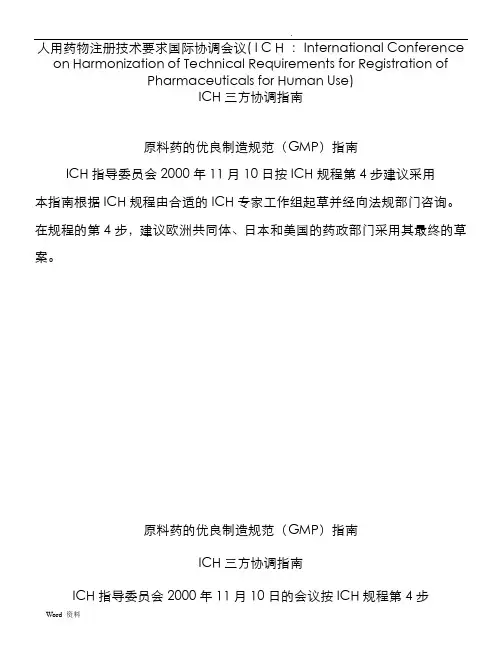
人用药物注册技术要求国际协调会议( I C H :International Conference on Harmonization of Technical Requirements for Registration ofPharmaceuticals for Human Use)ICH三方协调指南原料药的优良制造规范(GMP)指南ICH指导委员会2000年11月10日按ICH规程第4步建议采用本指南根据ICH规程由合适的ICH专家工作组起草并经向法规部门咨询。
在规程的第4步,建议欧洲共同体、日本和美国的药政部门采用其最终的草案。
原料药的优良制造规范(GMP)指南ICH三方协调指南ICH指导委员会2000年11月10日的会议按ICH规程第4步建议ICH的三个药政部门采用本指南目录1 引言INTRODUCTION (6)1.1 目的Objective (6)1.2 法规的适用性Regulatory Applicability (7)1.3 范围Range (7)2 质量管理QUALITY MANAGEMENT (9)2.1 原则Principles (9)2.2 质量部门的职责Responsibilities of the Quality Unit(s) (10)2.3 生产作业的职责Responsibility for Production Activities (12)2.4 内部审计(自检)Internal Audits (Self Inspection) (13)2.5 产品质量审核Product Quality Review (13)3 人员PERSONNEL (14)3.1 员工的资质Personnel qualifications (14)3.2 员工的卫生Personnel Hygiene (14)3.3 顾问Consultants (15)4 建筑和设施BUILDINGS AND FACILITIES (15)4.1 设计和结构Design and Construction (15)4.2 公用设施Utilities (16)4.3 水Water (17)4.4 限制Containment (18)4.5 照明Lighting (18)4.6 排污和垃圾Sewage and Refuse (18)4.7 清洁和保养Sanitation and Maintenance (19)5 工艺设备PROCESS EQUIPMENT (19)5.1 设计和结构Design and Construction (19)5.2 设备保养和清洁Equipment Maintenance and Cleaning (20)5.3 校验Calibration (21)5.4 计算机控制系统Computerized Systems (22)6 文件和记录DOCUMENTATION AND RECORDS (23)6.1 文件系统和规格Documentation System and Specifications (23)6.2 设备的清洁和使用记录Equipment Cleaning and Use Record (24)6.3 原料、中间体、原料药的标签和包装材料的记录Records of Materials , Intermediates, API Labelingand Packaging Materials (25)6.4 生产工艺规程Master Production Instructions (25)6.5 批生产记录Batch Production Records (26)6.6 实验室控制记录Laboratory Control Records (27)6.7 批生产记录审核Batch Production Record Review (28)7 物料管理MATERIALS MANAGEMENT (29)7.1 控制通则General Controls (29)7.2 接收和待验Receipt and Quarantine (30)7.3 进厂物料的取样和测试Sampling and Testing of Incoming Production Materials (30)7.4 储存Storage (32)7.5 重新评估Re-evaluation (32)8 生产和中间控制PRODUCTION AND IN-PROCESS CONTROLS (32)8.1 生产操作Production Operations (32)8.2 时间限制Time Limits (33)8.3 工序间的取样和控制In-process Sampling and Controls (34)8.4 中间体或原料药的混合Blending Batches of Intermediates or APIs (35)8.5 污染的控制Contamination Control (36)9 原料药和中间体的包装和贴签PACKAGING AND IDENTIFICATION LABELING OF APIs AND INTERMEDIATES (36)9.1 总则General (36)9.2 包装材料Packaging Materials (37)9.3 标签的发放和控制Labeling Issuance and Control (37)9.4 包装和贴签操作Packaging and Labeling Operations (38)10 储存和分发STORAGE AND DISTRIBUTION (39)10.1 入库程序Warehousing Procedures (39)10.2 分发程序Distribution Procedures (39)11 实验室控制LABORATORY CONTROLS (40)11.1 控制通则General Controls (40)11.2 中间体和原料药的测试Testing of Intermediates and APIs (41)11.3 分析程序的验证-参见12章Validation of Analytical Procedures - See Section 12. (11.3) (42)11.4 分析报告单Certificates of Analysis (42)11.5 原料药的稳定性监测Stability Monitorint of APIs (43)11.6 有效期和复验日期Expiry and Retest Dating (44)11.7 留样Reserve/Retention Samples (45)12 验证VALIDATION (45)12.1 验证方针Validation Policy (45)12.2 验证文件Validation Documentation (46)12.3 确认Qualification (46)12.4 工艺验证的方法Approaches to Process Validation (47)12.5 工艺验证的程序Process Validation Program (48)12.7 清洗验证Cleaning Validation (49)12.8 分析方法的验证Validation of Analytical Methods (51)13 变更的控制CHANGE CONTROL (51)14 物料的拒收和再用REJECTION AND RE-USE OF MATERIALS (52)14.1 拒收Rejection (52)14.2 返工Reprocessing (53)14.3 重新加工Reworking (53)14.4 物料和溶剂的回收Recovery of Materials and Solvents (54)14.5 退货Returns (54)15 投诉和召回COMPLAINTS AND RECALLS (55)16 协议制造商(包括实验室) CONTRACT MANUFACTURES (INCLUDING LABORATORIES) (56)17 代理商、经纪人、贸易商、经销商、重新包装者和重新贴签者 (57)AGENTS,BROKERS, TRADERS,DISTRIBUTORS,REPACKERS ,AND RELABELLERS (57)17.1 适用性Applicability (57)17.2 已分发原料药的可追溯性Traceability of Distributed APIs and Intermediates (57)17.3 质量管理Quality Management (57)17.4 原料药和中间体的重新包装、重新贴签和待检Repackaging,Relabeling,and Holding of APIs andIntermediates. (58)17.5 稳定性Stability (58)17.6 信息的传达Transfer of Information (58)17.7 投诉和召回的处理Handing of Complaints and Recalls (59)17.8 退货的处理Handing of Returns (59)18 用细胞繁殖/发酵生产的原料药的特殊指南 (59)SPECIFIC GUIDANCE FOR APIs MANUFACTURED BY CELL CULTURE/FERMENTATION (59)18.1 总则General (59)18.2 细胞库的维护和记录的保存Cell Bank Maintenance and Record Keeping (62)18.3 细胞繁殖/发酵Cell Culture/Fermentation (62)18.4 收取、分离和精制Harvesting, Isolation and Purifation (63)18.5 病毒的去除/灭活步骤Viral Removal/Inactivation Steps (64)19 用于临床研究的原料药(APIS FOR USE IN CLINICAL TRIALS) (65)19.1 总则General (65)19.2 质量quality (65)19.3 设备和设施Equipment and Facilities (66)19.4 原料的控制Control of Raw Materials (66)19.5 生产Production (66)19.6 验证Validation (67)19.7 变更Changes (67)19.8 实验室控制Laboratory Controls (67)19.9 文件Documentation (67)20. 术语表(GLOOSSARY) (68)原料药的优良制造规范(GMP) 指南Guidance for IndustryQ7A Good Manufacturing Practice Guidancefor Active Pharmaceutical IngredientsThis guidance represents the Food and Drug Administration's (FDA's) current thinking on this topic. It does not create or confer any rights for or on any person and does not operate to bind FDA or the public. An alternative approach may be used if such approach satisfies the requirements of the applicable statutes and regulations.1 引言INTRODUCTION1.1 目的Objective本文件(指南)旨在为在合适的质量管理体系下制造活性药用成分(原料药以下称原料药)提供有关优良药品生产管理规范(GMP)提供指南。
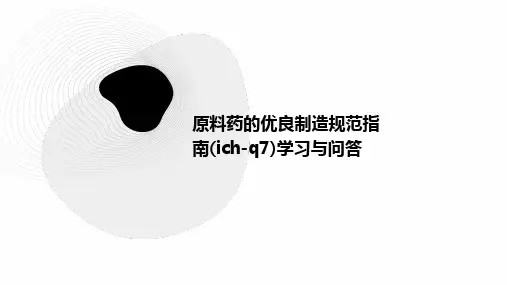
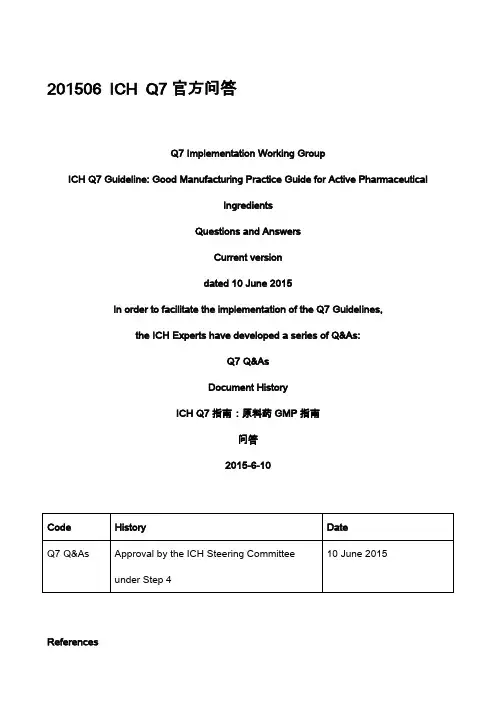
201506 ICH Q7官方问答Q7 Implementation Working GroupICH Q7 Guideline: Good Manufacturing Practice Guide for Active PharmaceuticalIngredientsQuestions and AnswersCurrent versiondated 10 June 2015In order to facilitate the implementation of the Q7 Guidelines,the ICH Experts have developed a series of Q&As:Q7 Q&AsDocument HistoryICH Q7指南:原料药GMP指南问答2015-6-10Code History DateQ7 Q&As Approval by the ICH Steering Committee10 June 2015under Step 4ReferencesThese documents are published at .ICH E2E Pharmacovigilance Planning November 2004ICH Q1A(R2) Stability testing of new drug substance and products February 2003ICH Q5A Quality of Biotechnological Products: Viral Safety Evaluation of Biotechnology Products Derivedfrom Cell Lines of Human or Animal Origin September 1999ICH Q5B Quality of biotechnological products: Analysis of the construct in cells used for the productionof r-DNA derived protein products November 2005ICH Q5D Quality of Biotechnological Products: Derivation and Characterisation of Cell Substrates Used for Production of Biotechnological/Biological Products July 1997ICH Q6B Specifications: Test Procedures and Acceptance Criteria forBiotechnological/Biological Products March 1999ICH Q7 Good Manufacturing Practice of APIs November 2000ICH Q8(R2) Pharmaceutical Development August 2009Part I: ‘Pharmaceutical Development’ November 2006Part II: ‘Annex to Pharmaceutical Development’, November 2008ICH Q9 Quality Risk Management and the ICH Q9 Briefing pack November 2005ICH Q10 Pharmaceutical Quality Systems June 2008ICH Q-IWG Training Programme for ICH Q8/Q9/Q10 November 2010ICH Q11 Development and Manufacturing of Active Pharmaceutical Ingredients May 2012 Legal Notice:This document is protected by copyright and may be used, reproduced, incorporated into other works, adapted, modified, translated or distributed under a public license provided that ICH's copyright in the document is acknowledged at all times. In caseof any adaption, modification or translation of the document, reasonable steps must be taken to clearly label, demarcate or otherwise identify that changes were made to or based on the original document. Any impression that the adaption, modification or translation of the original document is endorsed or sponsored by the ICH must be avoided.The document is provided "as is" without warranty of any kind. In no event shall the ICH or the authors of the original document be liable for any claim, damages or other liability arising from the use of the document.The above-mentioned permissions do not apply to content supplied by third parties. Therefore, for documents where the copyright vests in a third party, permission for reproduction must be obtained from this copyright holder.Table of ContentsPREFACE .............................................................................................................................. .. (1)1. INTRODUCTION -SCOPE (2)2. QUALITYMANAGEMENT (2)3.PERSONNEL ......................................................................................................................... . (3)4. BUILDINGS AND FACILITIES – CONTAINMENT (4)5. PROCESS EQUIPMENT –CLEANING (5)6. DOCUMENTATION ANDRECORDS (6)7. MATERIALSMANAGEMENT (7)8. PRODUCTION AND IN-PROCESSCONTROLS (8)9. PACKAGING AND IDENTIFICATION LABELLING OF APIS ANDINTERMEDIATES .................................................................................................................. .. (8)10. STORAGE ANDDISTRIBUTION (8)11. LABORATORYCONTROLS (9)12.VALIDATION (11)13. CHANGECONTROL (11)14. REJECTION AND REUSE OF MATERIALS (12)15. COMPLAINTS AND RECALLS (12)16. CONTRACT MANUFACTURERS (INCLUDINGLABORATORIES) .................................................................................................................. . (13)17. AGENTS, BROKERS, TRADERS, DISTRIBUTORS, REPACKERS, AND RELABELLERS ..................................................................................................................... .. (14)18. SPECIFIC GUIDANCE FOR APIS MANUFACTURED BY CELLCULTURE/FERMENTATION ................................................................................................ (15)19. APIS FOR USE IN CLINICAL TRIALS (15)20.GLOSSARY (16)21. ANNEX: Q&AS LINKED TO THE RESPECTIVE SECTIONS OF ICH Q7 (17)。
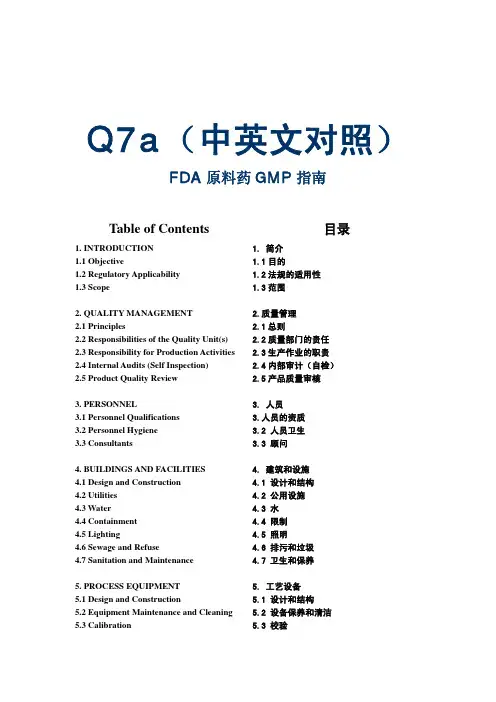
Q7a(中英文对照)FDA原料药GMP指南Table of Contents 目录1. INTRODUCTION 1. 简介1.1 Objective 1.1目的1.2 Regulatory Applicability 1.2法规的适用性1.3 Scope 1.3范围2. QUALITY MANAGEMENT 2.质量管理2.1 Principles 2.1总则2.2 Responsibilities of the Quality Unit(s) 2.2质量部门的责任2.3 Responsibility for Production Activities 2.3生产作业的职责2.4 Internal Audits (Self Inspection) 2.4内部审计(自检)2.5 Product Quality Review 2.5产品质量审核3. PERSONNEL 3. 人员3.1 Personnel Qualifications 3.人员的资质3.2 Personnel Hygiene 3.2 人员卫生3.3 Consultants 3.3 顾问4. BUILDINGS AND FACILITIES 4. 建筑和设施4.1 Design and Construction 4.1 设计和结构4.2 Utilities 4.2 公用设施4.3 Water 4.3 水4.4 Containment 4.4 限制4.5 Lighting 4.5 照明4.6 Sewage and Refuse 4.6 排污和垃圾4.7 Sanitation and Maintenance 4.7 卫生和保养5. PROCESS EQUIPMENT 5. 工艺设备5.1 Design and Construction 5.1 设计和结构5.2 Equipment Maintenance and Cleaning 5.2 设备保养和清洁5.3 Calibration 5.3 校验5.4 Computerized Systems5.4 计算机控制系统6. DOCUMENTATION AND RECORDS6. 文件和记录 6.1 Documentation System andSpecifications6.1 文件系统和质量标准 6.2 Equipment cleaning and Use Record6.2 设备的清洁和使用记录 6.3 Records of Raw Materials,Intermediates, API Labeling and Packaging Materials6.3 原料、中间体、原料药的标签和包装材料的记录 6.4 Master Production Instructions (Master Production and Control Records)6.4 生产工艺规程(主生产和控制记录) 6.5 Batch Production Records (Batch Production and Control Records)6.5 批生产记录(批生产和控制记录) 6.6 Laboratory Control Records6.6 实验室控制记录 6.7 Batch Production Record Review6.7批生产记录审核7. MATERIALS MANAGEMENT7. 物料管理 7.1 General Controls7.1 控制通则 7.2 Receipt and Quarantine7.2接收和待验 7.3 Sampling and Testing of Incoming Production Materials7.3 进厂物料的取样与测试 7.4 Storage7.4储存 7.5 Re-evaluation7.5复验8. PRODUCTION AND IN-PROCESS CONTROLS8. 生产和过程控制 8.1 Production Operations8.1 生产操作 8.2 Time Limits8.2 时限 8.3 In-process Sampling and Controls8.3 工序取样和控制 8.4 Blending Batches of Intermediates or APIs8.4 中间体或原料药的混批 8.5 Contamination Control8.5 污染控制9. PACKAGING AND IDENTIFICATION LABELING OF APIs AND INTERMEDIATES9. 原料药和中间体的包装和贴签 9.1 General9.1 总则 9.2 Packaging Materials9.2 包装材料 9.3 Label Issuance and Control9.3 标签发放与控制 9.4 Packaging and Labeling Operations9.4 包装和贴签操作10. STORAGE AND DISTRIBUTION10.储存和分发 10.1 Warehousing Procedures10.1 入库程序 10.2 Distribution Procedures10.2 分发程序11. LABORATORY CONTROLS11.实验室控制 11.1 General Controls11.1 控制通则 11.2 Testing of Intermediates and APIs11.2 中间体和原料药的测试 11.3 Validation of Analytical Procedures11.3 分析方法的验证 11.4 Certificates of Analysis11.4 分析报告单 11.5 Stability Monitoring of APIs11.5 原料药的稳定性监测 11.6 Expiry and Retest Dating11.6 有效期和复验期 11.7 Reserve/Retention Samples11.7 留样12. V ALIDATION12.验证 12.1 Validation Policy12.1 验证方针 12.2 Validation Documentation12.2 验证文件 12.3 Qualification12.3 确认 12.4 Approaches to Process Validation12.4 工艺验证的方法 12.5 Process Validation Program12.5 工艺验证的程序 12.6 Periodic Review of Validated Systems12.6验证系统的定期审核 12.7 Cleaning Validation12.7 清洗验证 12.8 Validation of Analytical Methods12.8 分析方法的验证13. CHANGE CONTROL13.变更的控制14. REJECTION AND RE-USE OFMATERIALS14.拒收和物料的再利用 14.1 Rejection14.1 拒收 14.2 Reprocessing14.2 返工 14.3 Reworking14.3 重新加工 14.4 Recovery of Materials and Solvents14.4 物料与溶剂的回收 14.5 Returns14.5 退货15. COMPLAINTS AND RECALLS15.投诉与召回16. CONTRACT MANUFACTURERS(INCLUDING LABORATORIES)16.协议生产商(包括实验室)17. AGENTS, BROKERS, TRADERS, DISTRIBUTORS, REPACKERS, ANDRELABELLERS17.代理商、经纪人、贸易商、经销商、重新包装者和重新贴签者 17.1 Applicability17.1适用性 17.2 Traceability of Distributed APIs and Intermediates17.2已分发的原料药和中间体的可追溯性 17.3 Quality Management17.3质量管理 17.4 Repackaging, Relabeling, and Holding of APIs and Intermediates17.4原料药和中间体的重新包装、重新贴签和待检17.5 Stability17.5稳定性 17.6 Transfer of Information17.6 信息的传达 17.7 Handling of Complaints and Recalls17.7 投诉和召回的处理 17.8 Handling of Returns17.8 退货的处理18. Specific Guidance for APIsManufactured by Cell Culture/Fermentation 18. 用细胞繁殖/发酵生产的原料药的特殊指南18.1 General18.1 总则 18.2 Cell Bank Maintenance and Record Keeping18.2细胞库的维护和记录的保存 18.3 Cell Culture/Fermentation18.3细胞繁殖/发酵 18.4 Harvesting, Isolation and Purification18.4收取、分离和精制 18.5 Viral Removal/Inactivation steps18.5 病毒的去除/灭活步骤19. APIs for Use in Clinical Trials19. 用于临床研究的原料药 19.1 General19.1 总则 19.2 Quality19.2 质量 19.3 Equipment and Facilities19.3 设备和设施 19.4 Control of Raw Materials19.4 原料的控制 19.5 Production19.5 生产 19.6 Validation19.6 验证 19.7 Changes19.7 变更 19.8 Laboratory Controls19.8 实验室控制 19.9 Documentation19.9 文件20. Glossary20. 术语Q7a GMP Guidance for APIsQ7a 原料药的GMP 指南1. INTRODUCTION1. 简介 1.1 Objective1.1目的 This document is intended to provide guidance regarding good manufacturing practice (GMP) for the manufacturing of active pharmaceutical ingredients (APIs) under an appropriate system for managing quality. It is also intended to help ensure that APIs meet the quality and purity characteristics that they purport, or are represented, to possess. 本文件旨在为在合适的质量管理体系下制造活性药用成分(以下称原料药)提供有关优良药品生产管理规范(GMP )提供指南。
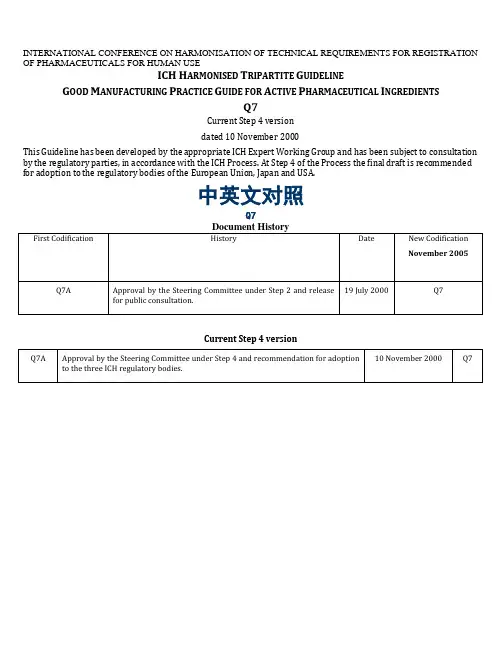
INTERNATIONAL CONFERENCE ON HARMONISATION OF TECHNICAL REQUIREMENTS FOR REGISTRATION OF PHARMACEUTICALS FOR HUMAN USEICH H ARMONISED T RIPARTITE G UIDELINEG OOD M ANUFACTURING P RACTICE G UIDE FOR A CTIVE P HARMACEUTICAL I NGREDIENTSQ7Current Step 4 versiondated 10 November 2000This Guideline has been developed by the appropriate ICH Expert Working Group and has been subject to consultation by the regulatory parties, in accordance with the ICH Process. At Step 4 of the Process the final draft is recommended for adoption to the regulatory bodies of the European Union, Japan and USA.中英文对照Q7Current Step 4 versionG OOD M ANUFACTURING P RACTICE G UIDE FOR A CTIVE P HARMACEUTICAL I NGREDIENTSICH Harmonised Tripartite GuidelineHaving reached Step 4 of the ICH Process at the ICH Steering Committee meeting on 10 November 2000, this guideline is recommended for adoption to the three regulatory parties to ICHTable of Contents 目录1. INTRODUCTION 1. 前言1.1 Objective 1.1 目的1.2 Regulatory Applicability 1.2 法规的适用性1.3 Scope 1.3 范围2. QUALITY MANAGEMENT 2.质量管理2.1 Principles 2.1 总则2.2 Responsibilities of the Quality Unit(s) 2.2 质量部门的责任2.3 Responsibility for Production Activities 2.3 生产的职责2.4 Internal Audits (Self Inspection) 2.4 内部审计(自检)2.5 Product Quality Review 2.5 产品质量回顾3. PERSONNEL 3. 人员3.1 Personnel Qualifications 3.1人员资格3.2 Personnel Hygiene 3.2 个人卫生3.3 Consultants 3.3 顾问4. BUILDINGS AND FACILITIES 4. 建筑和设施4.1 Design and Construction 4.1 设计和建造4.2 Utilities 4.2 公用设施4.3 Water 4.3 水4.4 Containment 4.4 特殊限制4.5 Lighting 4.5 照明4.6 Sewage and Refuse 4.6 污物和废弃物4.7 Sanitation and Maintenance 4.7 卫生和维护5. PROCESS EQUIPMENT 5. 工艺设备5.1 Design and Construction 5.1 设计和建造5.2 Equipment Maintenance and Cleaning 5.2 设备维护和清洁5.3 Calibration 5.3 校验5.4 Computerized Systems 5.4 计算机控制系统6. DOCUMENTATION AND RECORDS 6. 文件和记录6.1 Documentation System and Specifications 6.1 文件系统和质量标准6.2 Equipment cleaning and Use Record 6.2 设备的清洁和使用记录6.3 Records of Raw Materials,Intermediates, 6.3 原料、中间体、原料药的标签和包装材料的记录API Labeling and Packaging Materials6.4 Master Production Instructions 6.4 主生产指令(主生产和控制记录)(Master Production and Control Records)6.5 Batch Production Records 6.5 批生产记录(批生产和控制记录)(BatchProduction and Control Records)6.6 Laboratory Control Records 6.6 实验室控制记录6.7 Batch Production Record Review 6.7 批生产记录审核7. MATERIALS MANAGEMENT 7. 物料管理7.1 General Controls 7.1 一般要求7.2 Receipt and Quarantine 7.2 接收和待验7.3 Sampling and Testing of Incoming Production Materials 7.3 来料的取样与检测7.4 Storage 7.4 储存7.5 Re-evaluation 7.5 再评价8. PRODUCTION AND IN-PROCESS CONTROLS 8. 生产管理和生产过程控制8.1 Production Operations 8.1 生产管理8.2 Time Limits 8.2 时限8.3 In-process Sampling and Controls 8.3 生产过程中的取样和控制8.4 Blending Batches of Intermediates or APIs 8.4 中间体或原料药的混批8.5 Contamination Control 8.5 污染控制9. PACKAGING AND IDENTIFICATION 9. 原料药和中间体的包装和贴签LABELING OF APIs AND INTERMEDIATES9.1 General 9.1 通则9.2 Packaging Materials 9.2 包装材料9.3 Label Issuance and Control 9.3 标签发放与管理9.4 Packaging and Labeling Operations 9.4 包装和贴签管理10. STORAGE AND DISTRIBUTION 10.储存和分发10.1 Warehousing Procedures 10.1 入库程序10.2 Distribution Procedures 10.2 分发程序11. LABORATORY CONTROLS 11.实验室管理11.1 General Controls 11.1通则11.2 Testing of Intermediates and APIs 11.2 中间体和原料药的检测11.3 Validation of Analytical Procedures 11.3 分析方法的验证11.4 Certificates of Analysis 11.4 检验报告11.5 Stability Monitoring of APIs 11.5 原料药的稳定性考察11.6 Expiry and Retest Dating 11.6 有效期和复验期11.7 Reserve/Retention Samples 11.7 留样12. VALIDATION 12.验证12.1 Validation Policy 12.1 验证方针12.2 Validation Documentation 12.2 验证文件12.3 Qualification 12.3 确认12.4 Approaches to Process Validation 12.4 工艺验证的方法12.5 Process Validation Program 12.5 工艺验证的程序12.6 Periodic Review of Validated Systems 12.6 对已验证的系统的定期回顾12.7 Cleaning Validation 12.7 清洗验证12.8 Validation of Analytical Methods 12.8 分析方法的验证13. CHANGE CONTROL 13.变更控制14. REJECTION AND RE-USE OF MATERIALS 14.物料的拒收和再利用14.1 Rejection 14.1 拒收14.2 Reprocessing 14.2 返工14.3 Reworking 14.3 重新加工14.4 Recovery of Materials and Solvents 14.4 物料与溶剂的回收14.5 Returns 14.5 退货15. COMPLAINTS AND RECALLS 15.投诉与召回16. CONTRACT MANUFACTURERS 16.协议生产商(包括实验室)(INCLUDING LABORATORIES)17. AGENTS, BROKERS, TRADERS, DISTRIBUTORS, 17.代理商、经纪人、贸易商、经销商、重新包装者REPACKERS, AND RELABELLERS 和重新贴签者17.1 Applicability 17.1 适用性17.2 Traceability of Distributed APIs and Intermediates 17.2 已分发的原料药和中间体的可追溯性17.3 Quality Management 17.3 质量管理17.4 Repackaging, Relabeling, and Holding of APIs and Intermediates 17.4 原料药和中间体的重新包装、重新贴签和待检17.5 Stability 17.5 稳定性17.6 Transfer of Information 17.6 信息的传达17.7 Handling of Complaints and Recalls 17.7 投诉和召回的处理17.8 Handling of Returns 17.8 退货的处理18. Specific Guidance for APIs Manufactured by Cell 18. 用细胞繁殖/发酵生产的原料药的特殊指南Culture/Fermentation18.1 General 18.1 总则18.2 Cell Bank Maintenance and Record Keeping 18.2 细胞库的维护和记录的保存18.3 Cell Culture/Fermentation 18.3 细胞繁殖/发酵18.4 Harvesting, Isolation and Purification 18.4 收取、分离和精制18.5 Viral Removal/Inactivation steps 18.5 病毒的去除/灭活步骤19. APIs for Use in Clinical Trials 19. 用于临床研究的原料药19.1 General 19.1 总则19.2 Quality 19.2 质量19.3 Equipment and Facilities 19.3 设备和设施19.4 Control of Raw Materials 19.4 原料的控制19.5 Production 19.5 生产19.6 Validation 19.6 验证19.7 Changes 19.7 变更19.8 Laboratory Controls 19.8 实验室控制19.9 Documentation 19.9 文件20. Glossary 20. 术语1. INTRODUCTION 1. 简介1.1 Objective 1.1 目的This document is intended to provide guidance regarding good manufacturing practice (GMP) for the manufacturing of active pharmaceutical ingredients (APIs) under an appropriate system for managing quality. It is also intended to help ensure that APIs meet the quality and purity characteristics that they purport, or are represented, to possess.本文件旨在提供在适当的体系下为了控制生产原料药的质量而实施的药品生产质量管理规范(GMP)的指南。
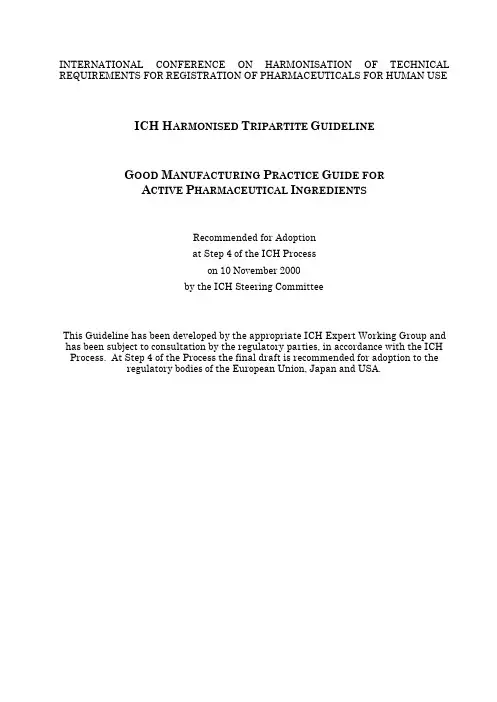
INTERNATIONAL CONFERENCE ON HARMONISATION OF TECHNICAL REQUIREMENTS FOR REGISTRATION OF PHARMACEUTICALS FOR HUMAN USE ICH H ARMONISED T RIPARTITE G UIDELINEG OOD M ANUFACTURING P RACTICE G UIDE FORA CTIVE P HARMACEUTICAL I NGREDIENTSRecommended for Adoptionat Step 4 of the ICH Processon 10 November 2000by the ICH Steering CommitteeThis Guideline has been developed by the appropriate ICH Expert Working Group and has been subject to consultation by the regulatory parties, in accordance with the ICH Process. At Step 4 of the Process the final draft is recommended for adoption to the regulatory bodies of the European Union, Japan and USA.G OOD M ANUFACTURING P RACTICE G UIDE FORA CTIVE P HARMACEUTICAL I NGREDIENTSICH Harmonised Tripartite GuidelineHaving reached Step 4 of the ICH Process at the ICH Steering Committee meeting on 10 November 2000, this guideline is recommended foradoption to the three regulatory parties to ICHTABLE OF CONTENTS1. INTRODUCTION (1)1.1 Objective (1)1.2 Regulatory Applicability (1)1.3 Scope (1)2. QUALITY MANAGEMENT (4)2.1 Principles (4)2.2 Responsibilities of the Quality Unit(s) (4)2.3 Responsibility for Production Activities (5)2.4 Internal Audits (Self Inspection) (5)2.5 Product Quality Review (6)3. PERSONNEL (6)3.1 Personnel Qualifications (6)3.2 Personnel Hygiene (6)3.3 Consultants (7)4. BUILDINGS AND FACILITIES (7)4.1 Design and Construction (7)4.2 Utilities (8)4.3 Water (8)4.4 Containment (9)4.5 Lighting (9)4.6 Sewage and Refuse (9)4.7 Sanitation and Maintenance (9)5. PROCESS EQUIPMENT (9)5.1 Design and Construction (9)5.2 Equipment Maintenance and Cleaning (10)5.3 Calibration (11)5.4 Computerized Systems (11)Good Manufacturing Practice Guide for Active Pharmaceutical Ingredients6. DOCUMENTATION AND RECORDS (12)6.1 Documentation System and Specifications (12)6.2 Equipment Cleaning and Use Record (13)6.3 Records of Raw Materials, Intermediates, API Labelling andPackaging Materials (13)6.4 Master Production Instructions(Master Production and Control Records) (13)6.5 Batch Production Records (Batch Production and Control Records).. 146.6 Laboratory Control Records (15)6.7 Batch Production Record Review (15)7. MATERIALS MANAGEMENT (16)7.1 General Controls (16)7.2 Receipt and Quarantine (16)7.3 Sampling and Testing of Incoming Production Materials (17)7.4 Storage (17)7.5 Re-evaluation (18)8. PRODUCTION AND IN-PROCESS CONTROLS (18)8.1 Production Operations (18)8.2 Time Limits (19)8.3 In-process Sampling and Controls (19)8.4 Blending Batches of Intermediates or APIs (19)8.5 Contamination Control (20)9. PACKAGING AND IDENTIFICATION LABELLING OF APIsAND INTERMEDIATES (20)9.1 General (20)9.2 Packaging Materials (21)9.3 Label Issuance and Control (21)9.4 Packaging and Labelling Operations (21)10. STORAGE AND DISTRIBUTION (22)10.1 Warehousing Procedures (22)10.2 Distribution Procedures (22)11. LABORATORY CONTROLS (23)11.1 General Controls (23)11.2 Testing of Intermediates and APIs (24)11.3 Validation of Analytical Procedures (24)11.4 Certificates of Analysis (24)Good Manufacturing Practice Guide for Active Pharmaceutical Ingredients11.5 Stability Monitoring of APIs (25)11.6 Expiry and Retest Dating (25)11.7 Reserve/Retention Samples (25)12. VALIDATION (26)12.1 Validation Policy (26)12.2 Validation Documentation (26)12.3 Qualification (27)12.4 Approaches to Process Validation (27)12.5 Process Validation Program (28)12.6 Periodic Review of Validated Systems (28)12.7 Cleaning Validation (28)12.8 Validation of Analytical Methods (29)13. CHANGE CONTROL (29)14. REJECTION AND RE-USE OF MATERIALS (30)14.1 Rejection (30)14.2 Reprocessing (30)14.3 Reworking (31)14.4 Recovery of Materials and Solvents (31)14.5 Returns (31)15. COMPLAINTS AND RECALLS (32)16. CONTRACT MANUFACTURERS (INCLUDING LABORATORIES). 3217. AGENTS, BROKERS, TRADERS, DISTRIBUTORS, REPACKERS,AND RELABELLERS (33)17.1 Applicability (33)17.2 Traceability of Distributed APIs and Intermediates (33)17.3 Quality Management (33)17.4 Repackaging, Relabelling and Holding of APIs and Intermediates (33)17.5 Stability (34)17.6 Transfer of Information (34)17.7 Handling of Complaints and Recalls (34)17.8 Handling of Returns (34)18. SPECIFIC GUIDANCE FOR APIs MANUFACTURED BY CELLCULTURE/FERMENTATION (35)18.1 General (35)18.2 Cell Bank Maintenance and Recordkeeping (36)18.3 Cell Culture/Fermentation (36)Good Manufacturing Practice Guide for Active Pharmaceutical Ingredients18.4 Harvesting, Isolation, and Purification (37)18.5 Viral Removal/Inactivation Steps (37)19. APIs FOR USE IN CLINICAL TRIALS (38)19.1 General (38)19.2 Quality (38)19.3 Equipment and Facilities (38)19.4 Control of Raw Materials (39)19.5 Production (39)19.6 Validation (39)19.7 Changes (39)19.8 Laboratory Controls (39)19.9 Documentation (39)20. GLOSSARY (40)G OOD M ANUFACTURING P RACTICE G UIDE FORA CTIVE P HARMACEUTICAL I NGREDIENTS1. INTRODUCTION1.1 ObjectiveThis document (Guide) is intended to provide guidance regarding good manufacturing practice (GMP) for the manufacturing of active pharmaceutical ingredients (APIs) under an appropriate system for managing quality. It is also intended to help ensure that APIs meet the requirements for quality and purity that they purport or are represented to possess.In this Guide “manufacturing” is defined to include all operations of receipt of materials, production, packaging, repackaging, labelling, relabelling, quality control, release, storage and distribution of APIs and the related controls. In this Guide the term “should” indicates recommendations that are expected to apply unless shown to be inapplicable or replaced by an alternative demonstrated to provide at least an equivalent level of quality assurance. For the purposes of this Guide, the terms “current good manufacturing practices” and “good manufacturing practices” are equivalent.The Guide as a whole does not cover safety aspects for the personnel engaged in the manufacture, nor aspects of protection of the environment. These controls are inherent responsibilities of the manufacturer and are governed by national laws.This Guide is not intended to define registration/filing requirements or modify pharmacopoeial requirements. This Guide does not affect the ability of the responsible regulatory agency to establish specific registration/filing requirements regarding APIs within the context of marketing/manufacturing authorizations or drug applications. All commitments in registration/filing documents must be met.1.2 Regulatory ApplicabilityWithin the world community, materials may vary as to the legal classification as an API. When a material is classified as an API in the region or country in which it is manufactured or used in a drug product, it should be manufactured according to this Guide.1.3 ScopeThis Guide applies to the manufacture of APIs for use in human drug (medicinal) products. It applies to the manufacture of sterile APIs only up to the point immediately prior to the APIs being rendered sterile. The sterilization and aseptic processing of sterile APIs are not covered by this guidance, but should be performed in accordance with GMP guidelines for drug (medicinal) products as defined by local authorities.This Guide covers APIs that are manufactured by chemical synthesis, extraction, cell culture/fermentation, by recovery from natural sources, or by any combination of these processes. Specific guidance for APIs manufactured by cell culture/fermentation is described in Section 18.Good Manufacturing Practice Guide for Active Pharmaceutical IngredientsThis Guide excludes all vaccines, whole cells, whole blood and plasma, blood and plasma derivatives (plasma fractionation), and gene therapy APIs. However, it does include APIs that are produced using blood or plasma as raw materials. Note that cell substrates (mammalian, plant, insect or microbial cells, tissue or animal sources including transgenic animals) and early process steps may be subject to GMP but are not covered by this Guide. In addition, the Guide does not apply to medical gases, bulk-packaged drug (medicinal) products, and manufacturing/control aspects specific to radiopharmaceuticals.Section 19 contains guidance that only applies to the manufacture of APIs used in the production of drug (medicinal) products specifically for clinical trials (investigational medicinal products).An “API Starting Material” is a raw material, intermediate, or an API that is used in the production of an API and that is incorporated as a significant structural fragment into the structure of the API. An API Starting Material can be an article of commerce, a material purchased from one or more suppliers under contract or commercial agreement, or produced in-house. API Starting Materials normally have defined chemical properties and structure.The company should designate and document the rationale for the point at which production of the API begins. For synthetic processes, this is known as the point at which "API Starting Materials" are entered into the process. For other processes (e.g. fermentation, extraction, purification, etc), this rationale should be established on a case-by-case basis. Table 1 gives guidance on the point at which the API Starting Material is normally introduced into the process.From this point on, appropriate GMP as defined in this Guide should be applied to these intermediate and/or API manufacturing steps. This would include the validation of critical process steps determined to impact the quality of the API. However, it should be noted that the fact that a company chooses to validate a process step does not necessarily define that step as critical.The guidance in this document would normally be applied to the steps shown in gray in Table 1. It does not imply that all steps shown should be completed. The stringency of GMP in API manufacturing should increase as the process proceeds from early API steps to final steps, purification, and packaging. Physical processing of APIs, such as granulation, coating or physical manipulation of particle size (e.g. milling, micronizing), should be conducted at least to the standards of this Guide.This GMP Guide does not apply to steps prior to the introduction of the defined "API Starting Material".Good Manufacturing Practice Guide for Active Pharmaceutical IngredientsTable 1: Application of this Guide to API ManufacturingType ofManufacturingApplication of this Guide to steps (shown in grey) used in this type ofmanufacturing ChemicalManufacturing Production of the APIStartingMaterialIntroduction of the API Starting Material into process Production of Intermediate(s) Isolation and purification Physical processing, and packaging API derived from animal sources Collection oforgan, fluid, ortissue Cutting, mixing, and/or initialprocessingIntroduction of the API Starting Material into process Isolation and purification Physical processing, and packaging API extracted from plant sources Collection of plants Cutting andinitialextraction(s) Introduction of the API StartingMaterial intoprocessIsolation and purification Physical processing, and packaging Herbal extracts used as API Collection of plants Cutting and initial extraction Further extraction Physicalprocessing,andpackagingAPI consisting of comminuted or powdered herbs Collection of plants and/or cultivation and harvesting Cutting/ comminuting Physicalprocessing,andpackagingBiotechnology: fermentation/ cell culture Establishment of master cell bank and working cell bank Maintenance of working cell bank Cell culture and/or fermentation Isolation and purification Physicalprocessing,andpackaging“Classical” Fermentation to produce an API Establishment of cell bank Maintenance of the cell bank Introduction of the cells into fermentation Isolation and purificationPhysicalprocessing,andpackagingGood Manufacturing Practice Guide for Active Pharmaceutical Ingredients2. QUALITY MANAGEMENT2.1 Principles2.10 Quality should be the responsibility of all persons involved in manufacturing.2.11 Each manufacturer should establish, document, and implement an effectivesystem for managing quality that involves the active participation of management and appropriate manufacturing personnel.2.12 The system for managing quality should encompass the organisational structure,procedures, processes and resources, as well as activities necessary to ensure confidence that the API will meet its intended specifications for quality and purity. All quality related activities should be defined and documented.2.13 There should be a quality unit(s) that is independent of production and thatfulfills both quality assurance (QA) and quality control (QC) responsibilities. This can be in the form of separate QA and QC units or a single individual or group, depending upon the size and structure of the organization.2.14 The persons authorised to release intermediates and APIs should be specified. 2.15 All quality related activities should be recorded at the time they are performed.2.16 Any deviation from established procedures should be documented and explained.Critical deviations should be investigated, and the investigation and its conclusions should be documented.2.17 No materials should be released or used before the satisfactory completion ofevaluation by the quality unit(s) unless there are appropriate systems in place to allow for such use (e.g. release under quarantine as described in Section 10.20 or the use of raw materials or intermediates pending completion of evaluation).2.18 Procedures should exist for notifying responsible management in a timely mannerof regulatory inspections, serious GMP deficiencies, product defects and related actions (e.g. quality related complaints, recalls, regulatory actions, etc.).2.2 Responsibilities of the Quality Unit(s)2.20 The quality unit(s) should be involved in all quality-related matters.2.21 The quality unit(s) should review and approve all appropriate quality-relateddocuments.2.22 The main responsibilities of the independent quality unit(s) should not bedelegated. These responsibilities should be described in writing and should include but not necessarily be limited to:1. Releasing or rejecting all APIs. Releasing or rejecting intermediates for useoutside the control of the manufacturing company;2. Establishing a system to release or reject raw materials, intermediates,packaging and labelling materials;3. Reviewing completed batch production and laboratory control records ofcritical process steps before release of the API for distribution;4. Making sure that critical deviations are investigated and resolved;5. Approving all specifications and master production instructions;6. Approving all procedures impacting the quality of intermediates or APIs;Good Manufacturing Practice Guide for Active Pharmaceutical Ingredients7. Making sure that internal audits (self-inspections) are performed;8. Approving intermediate and API contract manufacturers;9. Approving changes that potentially impact intermediate or API quality;10. Reviewing and approving validation protocols and reports;11. Making sure that quality related complaints are investigated and resolved;12. Making sure that effective systems are used for maintaining and calibratingcritical equipment;13. Making sure that materials are appropriately tested and the results arereported;14. Making sure that there is stability data to support retest or expiry dates andstorage conditions on APIs and/or intermediates where appropriate; and15. Performing product quality reviews (as defined in Section 2.5).2.3 Responsibility for Production ActivitiesThe responsibility for production activities should be described in writing, and should include but not necessarily be limited to:1. Preparing, reviewing, approving and distributing the instructions for theproduction of intermediates or APIs according to written procedures;2. Producing APIs and, when appropriate, intermediates according to pre-approved instructions;3. Reviewing all production batch records and ensuring that these arecompleted and signed;4. Making sure that all production deviations are reported and evaluated andthat critical deviations are investigated and the conclusions are recorded;5. Making sure that production facilities are clean and when appropriatedisinfected;6. Making sure that the necessary calibrations are performed and recordskept;7. Making sure that the premises and equipment are maintained and recordskept;8. Making sure that validation protocols and reports are reviewed andapproved;9. Evaluating proposed changes in product, process or equipment; and10. Making sure that new and, when appropriate, modified facilities andequipment are qualified.2.4 Internal Audits (Self Inspection)2.40 In order to verify compliance with the principles of GMP for APIs, regularinternal audits should be performed in accordance with an approved schedule. 2.41 Audit findings and corrective actions should be documented and brought to theattention of responsible management of the firm. Agreed corrective actions should be completed in a timely and effective manner.2.5 Product Quality Review2.50 Regular quality reviews of APIs should be conducted with the objective ofverifying the consistency of the process. Such reviews should normally be conducted and documented annually and should include at least:− A review of critical in-process control and critical API test results;− A review of all batches that failed to meet established specification(s);− A review of all critical deviations or non-conformances and related investigations;− A review of any changes carried out to the processes or analytical methods;− A review of results of the stability monitoring program;− A review of all quality-related returns, complaints and recalls; and− A review of adequacy of corrective actions.2.51 The results of this review should be evaluated and an assessment made ofwhether corrective action or any revalidation should be undertaken. Reasons for such corrective action should be documented. Agreed corrective actions should be completed in a timely and effective manner.3. PERSONNEL3.1 Personnel Qualifications3.10 There should be an adequate number of personnel qualified by appropriateeducation, training and/or experience to perform and supervise the manufacture of intermediates and APIs.3.11 The responsibilities of all personnel engaged in the manufacture of intermediatesand APIs should be specified in writing.3.12 Training should be regularly conducted by qualified individuals and should cover,at a minimum, the particular operations that the employee performs and GMP as it relates to the employee's functions. Records of training should be maintained.Training should be periodically assessed.3.2 Personnel Hygiene3.20 Personnel should practice good sanitation and health habits.3.21 Personnel should wear clean clothing suitable for the manufacturing activity withwhich they are involved and this clothing should be changed when appropriate.Additional protective apparel, such as head, face, hand, and arm coverings, should be worn when necessary, to protect intermediates and APIs from contamination.3.22 Personnel should avoid direct contact with intermediates or APIs.3.23 Smoking, eating, drinking, chewing and the storage of food should be restricted tocertain designated areas separate from the manufacturing areas.3.24 Personnel suffering from an infectious disease or having open lesions on theexposed surface of the body should not engage in activities that could result in compromising the quality of APIs. Any person shown at any time (either by medical examination or supervisory observation) to have an apparent illness or open lesions should be excluded from activities where the health condition could adversely affect the quality of the APIs until the condition is corrected orqualified medical personnel determine that the person's inclusion would not jeopardize the safety or quality of the APIs.3.3 Consultants3.30 Consultants advising on the manufacture and control of intermediates or APIsshould have sufficient education, training, and experience, or any combination thereof, to advise on the subject for which they are retained.3.31 Records should be maintained stating the name, address, qualifications, and typeof service provided by these consultants.4. BUILDINGS AND FACILITIES4.1 Design and Construction4.10 Buildings and facilities used in the manufacture of intermediates and APIs shouldbe located, designed, and constructed to facilitate cleaning, maintenance, and operations as appropriate to the type and stage of manufacture. Facilities should also be designed to minimize potential contamination. Where microbiological specifications have been established for the intermediate or API, facilities should also be designed to limit exposure to objectionable microbiological contaminants as appropriate.4.11 Buildings and facilities should have adequate space for the orderly placement ofequipment and materials to prevent mix-ups and contamination.4.12 Where the equipment itself (e.g., closed or contained systems) provides adequateprotection of the material, such equipment can be located outdoors.4.13 The flow of materials and personnel through the building or facilities should bedesigned to prevent mix-ups or contamination.4.14 There should be defined areas or other control systems for the followingactivities:− Receipt, identification, sampling, and quarantine of incoming materials, pending release or rejection;− Quarantine before release or rejection of intermediates and APIs;− Sampling of intermediates and APIs;− Holding rejected materials before further disposition (e.g., return, reprocessing or destruction);− Storage of released materials;− Production operations;− Packaging and labelling operations; and− Laboratory operations.4.15 Adequate, clean washing and toilet facilities should be provided for personnel.These washing facilities should be equipped with hot and cold water as appropriate, soap or detergent, air driers or single service towels. The washing and toilet facilities should be separate from, but easily accessible to, manufacturing areas. Adequate facilities for showering and/or changing clothes should be provided, when appropriate.4.16 Laboratory areas/operations should normally be separated from production areas.Some laboratory areas, in particular those used for in-process controls, can be located in production areas, provided the operations of the production process do not adversely affect the accuracy of the laboratory measurements, and the laboratory and its operations do not adversely affect the production process or intermediate or API.4.2 Utilities4.20 All utilities that could impact on product quality (e.g. steam, gases, compressedair, and heating, ventilation and air conditioning) should be qualified and appropriately monitored and action should be taken when limits are exceeded.Drawings for these utility systems should be available.4.21 Adequate ventilation, air filtration and exhaust systems should be provided,where appropriate. These systems should be designed and constructed to minimise risks of contamination and cross-contamination and should include equipment for control of air pressure, microorganisms (if appropriate), dust, humidity, and temperature, as appropriate to the stage of manufacture.Particular attention should be given to areas where APIs are exposed to the environment.4.22 If air is recirculated to production areas, appropriate measures should be takento control risks of contamination and cross-contamination.4.23 Permanently installed pipework should be appropriately identified. This can beaccomplished by identifying individual lines, documentation, computer control systems, or alternative means. Pipework should be located to avoid risks of contamination of the intermediate or API.4.24 Drains should be of adequate size and should be provided with an air break or asuitable device to prevent back-siphonage, when appropriate.4.3 Water4.30 Water used in the manufacture of APIs should be demonstrated to be suitable forits intended use.4.31 Unless otherwise justified, process water should, at a minimum, meet WorldHealth Organization (WHO) guidelines for drinking (potable) water quality.4.32 If drinking (potable) water is insufficient to assure API quality, and tighterchemical and/or microbiological water quality specifications are called for, appropriate specifications for physical/chemical attributes, total microbial counts, objectionable organisms and/or endotoxins should be established.4.33 Where water used in the process is treated by the manufacturer to achieve adefined quality, the treatment process should be validated and monitored with appropriate action limits.4.34 Where the manufacturer of a non-sterile API either intends or claims that it issuitable for use in further processing to produce a sterile drug (medicinal) product, water used in the final isolation and purification steps should be monitored and controlled for total microbial counts, objectionable organisms, and endotoxins.4.4 Containment4.40 Dedicated production areas, which can include facilities, air handling equipmentand/or process equipment, should be employed in the production of highly sensitizing materials, such as penicillins or cephalosporins.4.41 Dedicated production areas should also be considered when material of aninfectious nature or high pharmacological activity or toxicity is involved (e.g., certain steroids or cytotoxic anti-cancer agents) unless validated inactivation and/or cleaning procedures are established and maintained.4.42 Appropriate measures should be established and implemented to prevent cross-contamination from personnel, materials, etc. moving from one dedicated area to another.4.43 Any production activities (including weighing, milling, or packaging) of highlytoxic non-pharmaceutical materials such as herbicides and pesticides should not be conducted using the buildings and/or equipment being used for the production of APIs. Handling and storage of these highly toxic non-pharmaceutical materials should be separate from APIs.4.5 Lighting4.50 Adequate lighting should be provided in all areas to facilitate cleaning,maintenance, and proper operations.4.6 Sewage and Refuse4.60 Sewage, refuse, and other waste (e.g., solids, liquids, or gaseous by-products frommanufacturing) in and from buildings and the immediate surrounding area should be disposed of in a safe, timely, and sanitary manner. Containers and/or pipes for waste material should be clearly identified.4.7 Sanitation and Maintenance4.70 Buildings used in the manufacture of intermediates and APIs should be properlymaintained and repaired and kept in a clean condition.4.71 Written procedures should be established assigning responsibility for sanitationand describing the cleaning schedules, methods, equipment, and materials to be used in cleaning buildings and facilities.4.72 When necessary, written procedures should also be established for the use ofsuitable rodenticides, insecticides, fungicides, fumigating agents, and cleaning and sanitizing agents to prevent the contamination of equipment, raw materials, packaging/labelling materials, intermediates, and APIs.5. PROCESS EQUIPMENT5.1 Design and Construction5.10 Equipment used in the manufacture of intermediates and APIs should be ofappropriate design and adequate size, and suitably located for its intended use, cleaning, sanitization (where appropriate), and maintenance.5.11 Equipment should be constructed so that surfaces that contact raw materials,intermediates, or APIs do not alter the quality of the intermediates and APIs beyond the official or other established specifications.5.12 Production equipment should only be used within its qualified operating range.。
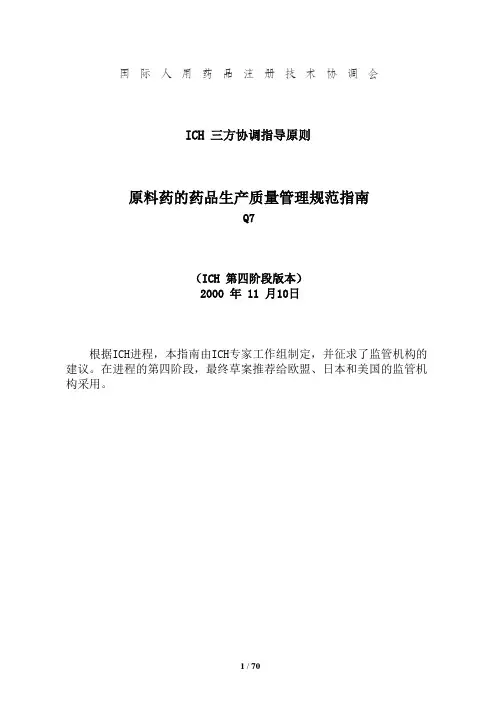
国际人用药品注册技术协调会ICH 三方协调指导原则原料药的药品生产质量管理规范指南Q7(ICH 第四阶段版本)2000 年 11 月10日根据ICH进程,本指南由ICH专家工作组制定,并征求了监管机构的建议。
在进程的第四阶段,最终草案推荐给欧盟、日本和美国的监管机构采用。
Q7现行第四阶段版本原料药的药品生产质量管理规范指南ICH 指导委员会在2000年11月10日完成了ICH进程的第四阶段,该指南推荐给ICH三方的监管机构采用。
目录1总则 (6)1.1目的 (6)1.2法规适用性 (6)1.3范围 (6)2质量管理 (9)2.1原则 (9)2.2质量管理部门的职责 (10)2.3生产部门的职责 (11)2.4内部审计(自检) (12)2.5产品质量回顾 (12)3人员 (13)3.1人员资质 (13)3.2人员卫生 (13)3.3顾问 (14)4厂房和设施 (14)4.1设计和建造 (14)4.2公用设施 (15)4.3水 (16)4.4控制 (17)4.5照明 (17)4.6污水和污物 (17)4.7卫生和维护 (17)5工艺设备 (18)5.1设计和构造 (18)5.2设备的维护和清洁 (19)5.3校准 (20)5.4计算机化系统 (20)6文件和记录 (21)6.1文件系统和质量标准 (21)6.2设备的清洁和使用记录 (22)6.3原料、中间体、原料药标签和包装材料的记录 (23)6.4工艺规程(主生产和检验记录) (23)6.5批生产记录(批生产和检验记录) (24)6.6检验记录 (26)6.7批生产记录审核 (27)7物料管理 (27)7.1原则 (27)7.2接收和待验 (28)7.3进厂物料的取样和检验 (29)7.4贮存 (30)7.5再评估 (30)8生产和过程控制 (30)8.1生产操作 (30)8.2时限 (32)8.3中间控制和取样 (32)8.4中间体或原料药的混合 (33)8.5污染的控制 (34)9原料药和中间体的包装和贴签 (34)9.1原则 (34)9.2包装材料 (35)9.3标签的发放和控制 (35)9.4包装和贴签操作 (36)10贮存和发运 (36)10.1入库规程 (36)10.2发运规程 (37)11实验室管理 (37)11.1基本原则 (37)11.2中间体和原料药的检测 (39)11.3分析方法的验证—参见第12节 (39)11.4检验报告 (39)11.5原料药稳定性考察 (40)11.6有效期和复验期 (41)11.7留样 (42)12验证 (42)12.1验证方针 (42)12.2验证文件 (43)12.3确认 (43)12.4工艺验证的方式 (44)12.5工艺验证程序 (45)12.6已验证系统的定期审核 (45)12.7清洁验证 (46)12.8分析方法的验证 (47)13.变更控制 (48)14物料的拒绝放行和再使用 (49)14.1拒绝放行 (49)14.2返工 (49)14.3重新加工 (49)14.4物料和溶剂的回收 (50)14.5退货 (50)15投诉和召回 (51)16受托生产商(包括实验室) (52)17.代理商、中间商、贸易商、经销商、分包装商和重新贴签方 (53)17.1适用性 (53)17.2已发运的原料药和中间体的可追溯性 (53)17.3质量管理 (54)17.4中间体和原料药的分包装、重新贴签和存放 (54)17.5稳定性 (54)17.6信息传递 (54)17.7投诉和召回的处理 (55)17.8退货处理 (55)18细胞培养/发酵生产原料药专用指南 (55)18.1通则 (55)18.2细胞库的维护和记录保存 (57)18.3细胞培养/发酵 (58)18.4收获、分离和纯化 (59)18.5病毒去除/灭活步骤 (60)19临床试验用原料药 (60)19.1通则 (60)19.2质量 (61)19.3设备和设施 (61)19.4原料的控制 (62)19.5生产 (62)19.6验证 (62)19.7变更 (63)19.8实验室控制 (63)19.9文件 (63)20.术语 (64)原料药的药品生产质量管理规范指南1总则1.1目的本指南旨在适宜的质量管理体系下为原料药(英文简称APIs)的生产提供药品生产质量管理规范(GMP)指导。
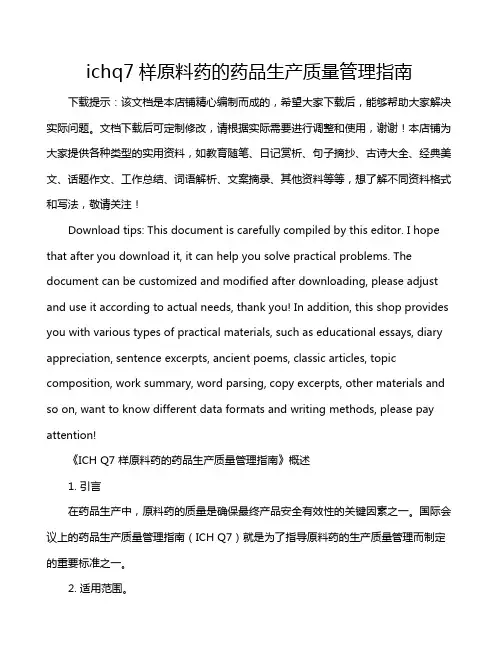
ichq7样原料药的药品生产质量管理指南下载提示:该文档是本店铺精心编制而成的,希望大家下载后,能够帮助大家解决实际问题。
文档下载后可定制修改,请根据实际需要进行调整和使用,谢谢!本店铺为大家提供各种类型的实用资料,如教育随笔、日记赏析、句子摘抄、古诗大全、经典美文、话题作文、工作总结、词语解析、文案摘录、其他资料等等,想了解不同资料格式和写法,敬请关注!Download tips: This document is carefully compiled by this editor. I hope that after you download it, it can help you solve practical problems. The document can be customized and modified after downloading, please adjust and use it according to actual needs, thank you! In addition, this shop provides you with various types of practical materials, such as educational essays, diary appreciation, sentence excerpts, ancient poems, classic articles, topic composition, work summary, word parsing, copy excerpts, other materials and so on, want to know different data formats and writing methods, please pay attention!《ICH Q7 样原料药的药品生产质量管理指南》概述1. 引言在药品生产中,原料药的质量是确保最终产品安全有效性的关键因素之一。
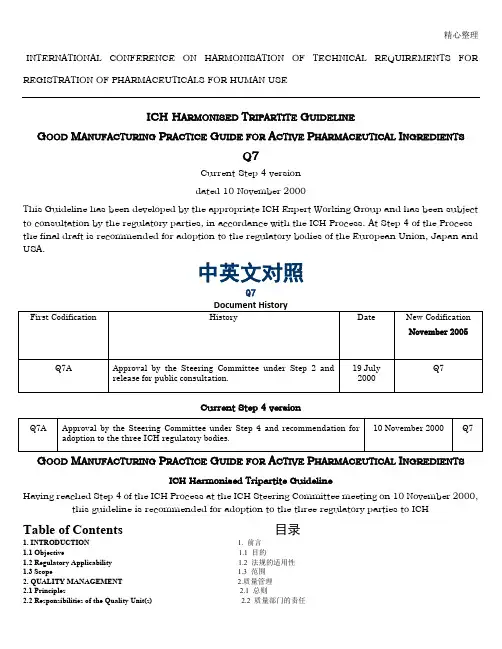
精心整理INTERNATIONAL CONFERENCE ON HARMONISATION OF TECHNICAL REQUIREMENTS FOR REGISTRATION OF PHARMACEUTICALS FOR HUMAN USEICH H ARMONISED T RIPARTITE G UIDELINEG OOD M ANUFACTURING P RACTICE G UIDE FOR A CTIVE P HARMACEUTICAL I NGREDIENTSQ7Having reached Step 4 of the ICH Process at the ICH Steering Committee meeting on 10 November 2000, this guideline is recommended for adoption to the three regulatory parties to ICHTable of Contents 目录1. INTRODUCTION 1. 前言1.1 Objective 1.1 目的1.2 Regulatory Applicability 1.2 法规的适用性1.3 Scope 1.3 范围2. QUALITY MANAGEMENT 2.质量管理2.1 Principles 2.1 总则2.2 Responsibilities of the Quality Unit(s) 2.2 质量部门的责任精心整理2.3 Responsibility for Production Activities 2.3 生产的职责2.4 Internal Audits (Self Inspection) 2.4 内部审计(自检)2.5 Product Quality Review 2.5 产品质量回顾3. PERSONNEL 3. 人员3.1 Personnel Qualifications 3.1人员资格3.2 Personnel Hygiene 3.2 个人卫生3.3 Consultants 3.3 顾问4. BUILDINGS AND FACILITIES 4. 建筑和设施4.1 Design and Construction 4.1 设计和建造4.2 Utilities 4.2 公用设施4.3 Water 4.3 水4.4 Containment 4.4 特殊限制4.5 Lighting 4.5 照明5.3 Calibration7.4 Storage8.2 Time Limits9.1 General9.3 Label Issuance and Control 9.3 标签发放与管理9.4 Packaging and Labeling Operations 9.4 包装和贴签管理10. STORAGE AND DISTRIBUTION 10.储存和分发10.1 Warehousing Procedures 10.1 入库程序10.2 Distribution Procedures 10.2 分发程序11. LABORATORY CONTROLS 11.实验室管理11.1 General Controls 11.1通则11.2 Testing of Intermediates and APIs 11.2 中间体和原料药的检测11.3 Validation of Analytical Procedures 11.3 分析方法的验证11.4 Certificates of Analysis 11.4 检验报告11.5 Stability Monitoring of APIs 11.5 原料药的稳定性考察11.6 Expiry and Retest Dating 11.6 有效期和复验期11.7 Reserve/Retention Samples 11.7 留样12. VALIDATION 12.验证精心整理12.1 Validation Policy 12.1 验证方针12.2 Validation Documentation 12.2 验证文件12.3 Qualification 12.3 确认12.4 Approaches to Process Validation 12.4 工艺验证的方法12.5 Process Validation Program 12.5 工艺验证的程序12.6 Periodic Review of Validated Systems 12.6 对已验证的系统的定期回顾12.7 Cleaning Validation 12.7 清洗验证12.8 Validation of Analytical Methods 12.8 分析方法的验证13. CHANGE CONTROL 13.变更控制14. REJECTION AND RE-USE OF MATERIALS 14.物料的拒收和再利用14.1 Rejection 14.1 拒收14.2 Reprocessing 14.2 返工14.3 Reworking 14.3 重新加工14.5 Returns17.5 Stability18.1 General19.1 General19.2 Quality19.5 Production19.6 Validation19.7 Changes20. Glossary1. INTRODUCTION 1. 简介1.1 Objective 1.1 目的This document is intended to provide guidance regarding good manufacturing practice (GMP) for the manufacturing of active pharmaceutical ingredients (APIs) under an appropriate system for managing quality. It is also intended to help ensure that APIs meet the quality and purity characteristics that they purport, or are represented, to possess.本文件旨在提供在适当的体系下为了控制生产原料药的质量而实施的药品生产质量管理规范(GMP)的指南。
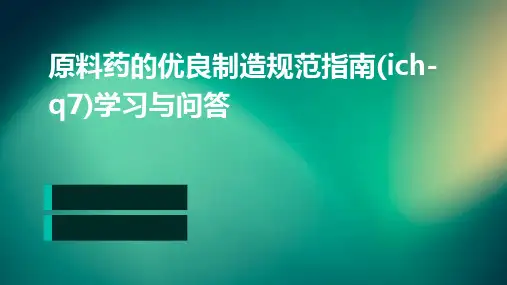
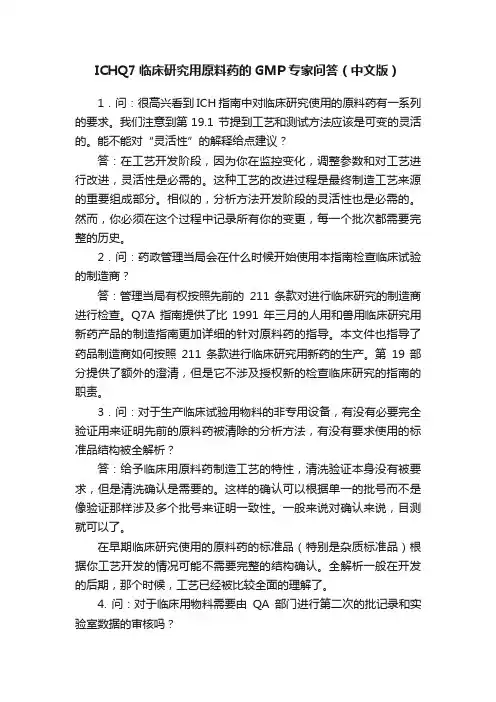
ICHQ7临床研究用原料药的GMP专家问答(中文版)1.问:很高兴看到ICH 指南中对临床研究使用的原料药有一系列的要求。
我们注意到第19.1 节提到工艺和测试方法应该是可变的灵活的。
能不能对“灵活性”的解释给点建议?答:在工艺开发阶段,因为你在监控变化,调整参数和对工艺进行改进,灵活性是必需的。
这种工艺的改进过程是最终制造工艺来源的重要组成部分。
相似的,分析方法开发阶段的灵活性也是必需的。
然而,你必须在这个过程中记录所有你的变更,每一个批次都需要完整的历史。
2.问:药政管理当局会在什么时候开始使用本指南检查临床试验的制造商?答:管理当局有权按照先前的211 条款对进行临床研究的制造商进行检查。
Q7A 指南提供了比1991 年三月的人用和兽用临床研究用新药产品的制造指南更加详细的针对原料药的指导。
本文件也指导了药品制造商如何按照211 条款进行临床研究用新药的生产。
第19 部分提供了额外的澄清,但是它不涉及授权新的检查临床研究的指南的职责。
3.问:对于生产临床试验用物料的非专用设备,有没有必要完全验证用来证明先前的原料药被清除的分析方法,有没有要求使用的标准品结构被全解析?答:给予临床用原料药制造工艺的特性,清洗验证本身没有被要求,但是清洗确认是需要的。
这样的确认可以根据单一的批号而不是像验证那样涉及多个批号来证明一致性。
一般来说对确认来说,目测就可以了。
在早期临床研究使用的原料药的标准品(特别是杂质标准品)根据你工艺开发的情况可能不需要完整的结构确认。
全解析一般在开发的后期,那个时候,工艺已经被比较全面的理解了。
4. 问:对于临床用物料需要由QA 部门进行第二次的批记录和实验室数据的审核吗?答: 第19 部分没有特别的解释质量审核的问题。
只是特别的提到质量部门必须批准或是拒收用于临床研究的每批原料药。
这里需要你使用一般的常识了。
如果你的工艺实际上是很复杂的,用到了一些难懂的化学合成方法,你的一般的质量人员可能不合适审核这些记录了。
人 用 药 物 注 册 技 术 要 求 国 际 协 调 会 议 ( I C H )ICH三 方 协 调 指 南原料药的优良制造规范(GMP)指南 ICH指导委员会2000年11月10日按ICH规程第4步建议采用本指南根据ICH规程由合适的ICH专家工作组起草并经向法规部门咨询。
在规程的第4步,建议欧洲共同体、日本和美国的药政部门采用其最终的草案。
原料药的优良制造规范(GMP)指南ICH三 方 协 调 指 南1.2.3.4.5.6.6.2 设备的清洁和使用记录 (12)6.3 原料、中间体、原料药的标签和包装材料的记录 (12)7.8.9.10.11.12.12.3 确认………………………………………………………………… 26 12.4工艺验证的方法 (26)13.14.15.16.17.18.19.19.7 变更 (39)19.8 实验室控制 (39)19.9 文件 (39)20.1 引言1.1 Array )提1.21.3品(述。
(第19(研究用医疗产品)的原料药制造。
1“原料药的起始物料”是指一种原料、中间体或原料药,用来生产一种原料药,或者以主要结构单元的形式被结合进原料药结构中。
原料药的起始物料可能是在市场上有售、能够中的本2.142.15调查,并记录调查经过及其结果。
22.17在质量部门对物料完成满意的评价之前,任何物料都不应当发放或使用,除非有合Array缺2.213表1:本指南在原料药生产中的应用413. 确保物料都经过了适当的检测并报告结果;14. 确保有稳定性数据支持中间体或原料药的复验期或有效期和储存条件;15. 开展产品质量审核(详见2.5节);2.42.402.412.52.502.5133.153.10 应当有足够数量的员工具备从事和监管原料药和中间体生产的教育、培训和/或经历等资格。
3.11 参与原料药和中间体生产的所有人员的职责应当书面规定。
3.123.23.203.213.223.233.243.33.303.3144.14.104.114.124.134.14- 来料的接收、鉴别、取样和待检,等待放行或拒收;- 中间体和原料药放行或拒收前的待验;- 中间体和原料药的取样;- 不合格物料处理 (如退货,返工或销毁)前的贮存;-4.154.164.24.20 ) 4.214.224.234.244.34.304.314.32 如果饮用水不足以确保原料药的质量,并要求更为严格的化学和/或微生物水质规格标准,应当制定合适的物理/化学特性、微生物总数、控制菌和/或内毒素的规格标4.334.34 (医4.44.404.414.424.434.54.504.64.604.74.704.714.725 工艺设备5.1 设计和结构5.10 中间体和原料药生产中使用的设备应当有合理的设计和足够的尺寸,并且放置在适宜于其使用、清洁、消毒(根据情况而定)和保养的地方。
Q7a(中英文对照)FDA原料药GMP指南Table of Contents 目录1. INTRODUCTION 1. 简介1.1 Objective 1.1目的1.2 Regulatory Applicability 1.2法规的适用性1.3 Scope 1.3范围2. QUALITY MANAGEMENT 2.质量管理2.1 Principles 2.1总则2.2 Responsibilities of the Quality Unit(s) 2.2质量部门的责任2.3 Responsibility for Production Activities 2.3生产作业的职责2.4 Internal Audits (Self Inspection) 2.4内部审计(自检)2.5 Product Quality Review 2.5产品质量审核3. PERSONNEL 3. 人员3.1 Personnel Qualifications 3.人员的资质3.2 Personnel Hygiene 3.2 人员卫生3.3 Consultants 3.3 顾问4. BUILDINGS AND FACILITIES 4. 建筑和设施4.1 Design and Construction 4.1 设计和结构4.2 Utilities 4.2 公用设施4.3 Water 4.3 水4.4 Containment 4.4 限制4.5 Lighting 4.5 照明4.6 Sewage and Refuse 4.6 排污和垃圾4.7 Sanitation and Maintenance 4.7 卫生和保养5. PROCESS EQUIPMENT 5. 工艺设备5.1 Design and Construction 5.1 设计和结构5.2 Equipment Maintenance and Cleaning 5.2 设备保养和清洁5.3 Calibration 5.3 校验5.4 Computerized Systems 5.4 计算机控制系统6. DOCUMENTATION AND RECORDS 6. 文件和记录6.1 Documentation System andSpecifications6.1 文件系统和质量标准6.2 Equipment cleaning and Use Record 6.2 设备的清洁和使用记录6.3 Records of Raw Materials, Intermediates, API Labeling and Packaging Materials 6.3 原料、中间体、原料药的标签和包装材料的记录6.4 Master Production Instructions (MasterProduction and Control Records)6.4 生产工艺规程(主生产和控制记录)6.5 Batch Production Records (BatchProduction and Control Records)6.5 批生产记录(批生产和控制记录)6.6 Laboratory Control Records 6.6 实验室控制记录6.7 Batch Production Record Review 6.7批生产记录审核7. MATERIALS MANAGEMENT 7. 物料管理7.1 General Controls 7.1 控制通则7.2 Receipt and Quarantine 7.2接收和待验7.3 Sampling and Testing of IncomingProduction Materials7.3 进厂物料的取样与测试7.4 Storage 7.4储存7.5 Re-evaluation 7.5复验8. PRODUCTION AND IN-PROCESSCONTROLS8. 生产和过程控制8.1 Production Operations 8.1 生产操作8.2 Time Limits 8.2 时限8.3 In-process Sampling and Controls 8.3 工序取样和控制8.4 Blending Batches of Intermediates orAPIs8.4 中间体或原料药的混批8.5 Contamination Control 8.5 污染控制9. PACKAGING AND IDENTIFICATIONLABELING OF APIs ANDINTERMEDIATES9. 原料药和中间体的包装和贴签9.1 General 9.1 总则9.2 Packaging Materials 9.2 包装材料9.3 Label Issuance and Control 9.3 标签发放与控制9.4 Packaging and Labeling Operations 9.4 包装和贴签操作10. STORAGE AND DISTRIBUTION 10.储存和分发10.1 Warehousing Procedures 10.1 入库程序10.2 Distribution Procedures 10.2 分发程序11. LABORATORY CONTROLS 11.实验室控制11.1 General Controls 11.1 控制通则11.2 Testing of Intermediates and APIs 11.2 中间体和原料药的测试11.3 Validation of Analytical Procedures 11.3 分析方法的验证11.4 Certificates of Analysis 11.4 分析报告单11.5 Stability Monitoring of APIs 11.5 原料药的稳定性监测11.6 Expiry and Retest Dating 11.6 有效期和复验期11.7 Reserve/Retention Samples 11.7 留样12. V ALIDATION 12.验证12.1 Validation Policy 12.1 验证方针12.2 Validation Documentation 12.2 验证文件12.3 Qualification 12.3 确认12.4 Approaches to Process Validation 12.4 工艺验证的方法12.5 Process Validation Program 12.5 工艺验证的程序12.6 Periodic Review of Validated Systems 12.6验证系统的定期审核12.7 Cleaning Validation 12.7 清洗验证12.8 Validation of Analytical Methods 12.8 分析方法的验证13. CHANGE CONTROL 13.变更的控制14. REJECTION AND RE-USE OFMATERIALS14.拒收和物料的再利用14.1 Rejection 14.1 拒收14.2 Reprocessing 14.2 返工14.3 Reworking 14.3 重新加工14.4 Recovery of Materials and Solvents 14.4 物料与溶剂的回收14.5 Returns 14.5 退货15. COMPLAINTS AND RECALLS 15.投诉与召回16. CONTRACT MANUFACTURERS(INCLUDING LABORATORIES)16.协议生产商(包括实验室)17. AGENTS, BROKERS, TRADERS, DISTRIBUTORS, REPACKERS, AND RELABELLERS 17.代理商、经纪人、贸易商、经销商、重新包装者和重新贴签者17.1 Applicability 17.1适用性17.2 Traceability of Distributed APIs andIntermediates17.2已分发的原料药和中间体的可追溯性17.3 Quality Management 17.3质量管理17.4 Repackaging, Relabeling, and Holding of APIs and Intermediates 17.4原料药和中间体的重新包装、重新贴签和待检17.5 Stability 17.5稳定性17.6 Transfer of Information 17.6 信息的传达17.7 Handling of Complaints and Recalls 17.7 投诉和召回的处理17.8 Handling of Returns 17.8 退货的处理18. Specific Guidance for APIs Manufactured by Cell Culture/Fermentation 18. 用细胞繁殖/发酵生产的原料药的特殊指南18.1 General 18.1 总则18.2 Cell Bank Maintenance and RecordKeeping18.2细胞库的维护和记录的保存18.3 Cell Culture/Fermentation 18.3细胞繁殖/发酵18.4 Harvesting, Isolation and Purification 18.4收取、分离和精制18.5 Viral Removal/Inactivation steps 18.5 病毒的去除/灭活步骤19.APIs for Use in Clinical Trials 19.用于临床研究的原料药19.1 General 19.1 总则19.2 Quality 19.2 质量19.3 Equipment and Facilities 19.3 设备和设施19.4 Control of Raw Materials 19.4 原料的控制19.5 Production 19.5 生产19.6 Validation 19.6 验证19.7 Changes 19.7 变更19.8 Laboratory Controls 19.8 实验室控制19.9 Documentation 19.9 文件20. Glossary 20. 术语Q7a GMP Guidance for APIs Q7a原料药的GMP指南1. INTRODUCTION 1. 简介1.1 Objective 1.1目的This document is intended to provide guidance regarding good manufacturing practice (GMP) for the manufacturing of active pharmaceutical ingredients (APIs) under an appropriate system for managing quality. It is also intended to help ensure that APIs meet the quality and purity characteristics that they purport, or are represented, to possess. 本文件旨在为在合适的质量管理体系下制造活性药用成分(以下称原料药)提供有关优良药品生产管理规范(GMP)提供指南。
ICH Q7原料药的优良制造规范(GMP)指南1. 引言1.1目的本文件旨在为在合适的质量管理体系下制造活性药用成分(以下称原料药)提供GMP指南。
以确保原料药符合预期的或应当具有的质量特性与纯度要求。
本指南中所指的“制造”包括物料接收、生产、包装、重新包装、贴签、重新贴签、质量控制、放行、原料药的储存和销售及其相关控制的一系列活动。
本指南中,“应当”一词表示“只要遵循,肯定符合GMP”的各种建议。
也可以采用其他方法和手段,只要他们能满足实际情况的具体需求。
本指南中的“现行优良生产管理规范(cGMP)”和“优良生产管理规范(GMP)”二者目标是等同的。
本指南在总体上未涉及生产人员的安全问题,亦不包括环保方面的内容。
这方面的管理是生产者固有的责任,应按国家有关法律法规管理。
本指南无意详述注册/登记备案的要求、修改药典的要求。
鉴于药品上市/制造授权或药品申请的情况,本指南不左右药政管理部门在审批原料药注册/登记备案方面的要求。
注册/登记备案中的所有承诺必须做到。
1.2法规的适用性在世界范围内,作为原料药的物质的法定分类存在差异。
不管在哪个国家或地区,当某种物料被称为原料药用于药品生产时,均应实施本指南。
1.3范围本指南适用于人用药品(医疗用品)所用原料药的生产。
它适用于无菌原料药在灭菌前的各个步骤,不包括无菌原料药的灭菌和无菌操作过程。
这些操作应符合所在国或区域的GMP指南。
本指南所适用的原料药包括通过化学合成、提取、细胞培养/发酵,自然资源利用或由这些工艺组合而生产的原料药。
对细胞培养/发酵生产的原料药的特殊指南,在第18章论述。
本指南不不适用于疫苗、完整细胞、全血和血浆、血和血浆的衍生物(血浆成分)和基因治疗的原料药。
但是适用于以血或血浆为原料生产的原料药。
应当说明,各种细胞基底(哺乳动物、植物、昆虫或微生物的细胞、组织或包括转基因动物在内的动物资源)及其前几道生产操作,可能应遵循GMP规范,但它们并未包括在本指南之内。
人用药品注册技术要求国际协调会(ICH)文件目录ICH的论题主要分为四类,因此ICH根据论题的类别不同而进行相应的编码分类:1. “Q”类论题:Q代表QUALITY,指那些与化工和医药,质量保证方面的相关的论题。
Q1/Q2...Q10都属于这类。
2. “S”类论题:S代表SAFETY,指那些与实验室和动物实验,临床前研究方面的相关的论题。
3. “E”类论题:E代表EFFICACY,指那些与人类临床研究相关的课题。
4. “M”类论题:M代表MULTIDISCIPLINARY, 指那些不可单独划入以上三个分类的交叉涉及的论题。
同时M又细分为5个小类:M1: 常用医学名词(Med DRA)M2: 药政信息传递之电子标准M3: 与临床试验相关的临床前研究时间的安排M4: 常规技术文件(CTD)M5: 药物词典的数据要素和标准一、ICH. 质量部分(Quality)稳定性1.Quality质量2.Q1: Stability稳定性3.Q1A(R2): Stability Testing of New Drug Substances and Products 新原料药和制剂的稳定性试验4.Q1B: Photostability Testing of New Drug Substances and Products 新原料药和制剂的光稳定性试验5.Q1C: Stability Testing for New Dosage Forms 新剂型的稳定性试验6.Q1D: Bracketing and Matrixing Designs for Stability Testing of Drug Substances and Drug Products原料药和制剂稳定性试验的交叉和矩阵设计 Q1E: Evaluation of Stability Data 稳定性数据的评估7.Q1F: Stability Data Package for Registration Applications in Climatic Zones III andIV在气候带III和IV,药物注册申请所提供的稳定性数据8.Q2: Analytical Validation分析验证9.Q2(R1): Validation of Analytical Procedures: Text and Methodology分析程序的验证:正文及方法论10.Q3: Impurities 杂质11.Q3A(R2): Impurities in New Drug Substances 新原料药中的杂质12.Q3B(R2): Impurities in New Drug Products (Revised Guideline) 新制剂中的杂质13.Q3C(R3): Impurities: Guideline for Residual Solvents 杂质:残留溶剂指南Impurities: Guideline for Residual Solvents (Maintenance) 杂质:残留溶剂指南(保留)PDE for Tetrahydrofuran (in Q3C(R3)) 四氢呋喃的日允许接触剂量PDE for N-Methylpyrrolidone (in Q3C(R3)) N-甲基吡咯烷酮的日允许接触剂量14.Q4: Pharmacopoeias药典15.Q4A: Pharmacopoeial Harmonisation 药典的协调16.Q4B: Evaluation and Recommendation of Pharmacopoeial Texts for Use in the ICH Regions药典内容的评估及推荐为用于ICH地区17.Q4B Annex1 Evaluation and Recommendation of Pharmacopoeial Texts for Use in the ICH Regionson Residue on Ignition/Sulphated Ash General Chapter附录1 药典内容的评估及推荐为用于ICH地区关于灼烧残渣/灰分常规篇18.Q4B Annex2 Evaluation and Recommendation of Pharmacopoeial Texts for Use in the ICH Regionson Test for Extractable Volume of Parenteral Preparations General Chapter附录2 药典内容的评估及推荐为用于ICH地区关于注射剂可提取容量测试常规篇19.Q4B Annex3 Evaluation and Recommendation of Pharmacopoeial Texts for Use in the ICH Regionson Test for Particulate Contamination: Sub-Visible Particles General Chapter附录3 药典内容的评估及推荐为用于ICH地区关于颗粒污染物测试:不溶性微粒常规篇20.Q5: Quality of Biotechnological Products 生物技术制品质量21.Q5A(R1): Viral Safety Evaluation of Biotechnology Products Derived from Cell Lines of Human or Animal Origin来源于人或者动物细胞系的生物技术产品的病毒安全性评估22.Q5B: Quality of Biotechnological Products: Analysis of the Expression Construct in Cells Used for Production of r-DNA Derived Protein Products生物技术产品的质量:源于重组DNA的蛋白质产品的生产中所用的细胞中的表达构建分析23.Q5C: Quality of Biotechnological Products: Stability Testing of Biotechnological/Biological Products生物技术产品的质量:生物技术/生物产品的稳定性试验24.Q5D: Derivation and Characterization of Cell Substrates Used for Production of Biotechnological/Biological Products用于生产生物技术/生物产品的细胞底物的起源和特征描述25.Q5E: Comparability of Biotechnological/Biological Products Subject to Changes inTheir Manufacturing Process基于不同生产工艺的生物技术产品/生物产品的可比较性26.Q6: Specifications规格27.Q6A: Specifications: Test Procedures and Acceptance Criteria for New Drug Substances and New Drug Products: Chemical Substances (including decision trees) 质量规格:新原料药和新制剂的检验程序和可接收标准:化学物质(包括决定过程)28.Q6B: Specifications: Test Procedures and Acceptance Criteria for29.Biotechnological/Biological Products质量规格:生物技术/生物产品的检验程序和可接收标准30.Q7: Good Manufacturing Practices (GMP)31.Q7A: Good Manufacturing Practice Guide for Active Pharmaceutical Ingredients活性药物成份的GMP指南32.Q8: Pharmaceutical Development药物研发33.Annex to Q8Q8附录34.Q9: Quality Risk Management质量风险管理35.Q10: Pharmaceutical Quality System药物质量体系二、ICH.安全性部分(Safety) 致癌试验1.S1A Guideline on the Need for Carcinogenicity Studies of Pharmaceuticals 药物致癌试验的必要性2.S1B Testing for Carcinogenicity of Pharmaceuticals 药物致癌试验3.S1C(R2) Dose Selection for Carcinogenicity Studies of Pharmaceuticals药物致癌试验的剂量选择4.S1C’药物致癌试验的剂量选择的附件:补充剂量限度和有关注释遗传毒性5.S2(R1) Guidance on Genotoxicity Testing and Data Interpretation forPharmaceuticals Intended for Human Use 人用药物的遗传毒性试验和数据分析指导原则6.S2A药物审评遗传毒性试验的特殊性指导原则7.S2B遗传毒性:药物遗传毒性试验标准组合药代8.S3A Note for Guidance on Toxicokinetics: The Assessment of Systemic Exposurein Toxicity Studies 毒代动力学指导原则:毒性研究中全身暴露的评价9.S3B Pharmacokinetics: Guidance for Repeated Dose Tissue Distribution Studies药代动力学:重复给药的组织分布研究指导原则慢性毒性10.S4Duration of Chronic Toxicity Testing in Animals (Rodent and Non RodentToxicity Testing) 动物慢性毒性试验的周期(啮齿类和非啮齿类)生殖毒性11.S5(R2) Detection of Toxicity to Reproduction for Medicinal Products andToxicity to Male Fertility (the Addendum dated November 1995 has beenincorporated into the core guideline in November 2005 )12.S5A药品的生殖毒性检测13.S5B雄性生育力毒性其他14.S6Preclinical Safety Evaluation of Biotechnology-Derived Pharmaceuticals 生物技术药品的临床前安全性试验15.S7A Safety Pharmacology Studies for Human Pharmaceuticals 人用药物的安全性药理研究16.S7B The Non-clinical Evaluation of the Potential for Delayed VentricularRepolarization (QT Interval Prolongation) by Human Pharmaceuticals人用药延迟心室复极化(QT间期延长)潜在作用的非临床评价指导原则17.S8Immunotoxicity Studies for Human Pharmaceuticals人类药品的免疫毒性研究18.S9 Nonclinical Evaluation for Anticancer Pharmaceuticals抗癌药物的临床前评价19.S10 Photosafety Evaluation三、ICH.临床部分(Efficacy)1.E1The Extent of Population Exposure to Assess Clinical Safety for Drugs Intended for Long-Term Treatment of Non-Life-Threatening Conditions 评价临床长期给药方案的安全性2.E2A Definitions and Standards for Expedited Reporting 快速报告的定义和标准3.E2B(R3) Data Elements for Transmission of Individual Case Safety Reports个体病例安全性报告传递的数据要素4.E2C Periodic Benefit-Risk Evaluation Report 上市药品定期安全性更新报告5.E2D Post-Approval Safety Data Management: Definitions and Standards for Expedited Reporting批准后安全性数据管理:快速报告的定义和标准6.E2E Pharmacovigilance Planning药物警戒计划7. E2F Development Safety Update Report8.E3Structure and Content of Clinical Study Reports 临床研究报告的结构与内容9.E4Dose-Response Information to Support Drug Registration 新药注册所需量-效关系的资料10.E5(R1)Ethnic Factors in the Acceptability of Foreign Clinical Data 对国外临床研究资料的种族因素的可接受性11.E6(R1) Good Clinical Practice: Consolidated Guideline 药品临床研究规范(GCP)一致性指导原则12.E7Studies in Support of Special Populations: Geriatrics 老年人群的临床研究13.E8General Considerations for Clinical Trials 临床试验的一般考虑14.E9Statistical Principles for Clinical Trials 临床试验统计原则15.E10Choice of Control Group and Related Issues in Clinical Trials 对照组的选择16.E11Clinical Investigation of Medicinal Products in the Pediatric Population 儿童人群的临床研究17.E12按治疗分类的各类药物临床评价E12 Principles for Clinical Evaluation of New Antihypertensive Drugs18.E14The Clinical Evaluation of QT/QTc Interval Prolongation and Proarrhythmic Potential for Non-Antiarrhythmic Drugs 非抗心律失常药物致QT/QTc间期延长及潜在心律失常作用的临床评价19.E15 Definitions for Genomic Biomarkers, Pharmacogenomics, Pharmacogenetics, Genomic Data and Sample Coding Categories20.E16 Biomarkers Related to Drug or Biotechnology Product Development: Context, Structure and Format of Qualification Submissions四、ICH.综合部分 (Multidisciplinary)1.M1医学术语Med DRA2.M2Electronic Transmission of Individual Case Safety Reports MessageSpecification (ICH ICSR DTD Version 2.1) companion document to E2B(R3)注册资料传递所需的电子代码3.M3Guidance on Nonclinical Safety Studies for the Conduct of Human ClinicalTrials and Marketing Authorization for Pharmaceuticals与临床研究有关的临床前研究的时间安排4.M4 Organisation of the Common Technical Document for the Registration ofPharmaceuticals for Human Use (Edited with Numbering and Section Header Changes, September 2002). Including the Annex : the Granularity Document(Revised November 2003).CTD(common technical document)(包括CTD、CTD-Q、CTD-S、CTD-E和eCTD)药品词汇的数据要素和标准5.M4Q (R1) The Common Technical Document for the Registration ofPharmaceuticals for Human Use: Quality (Edited with Numbering and Section Header Changes, September 2002)6.M4S (R2) The Common Technical Document for the Registration ofPharmaceuticals for Human Use: Safety (Edited with Numbering and SectionHeader Changes, September 2002)7.M4E (R1) The Common Technical Document for the Registration ofPharmaceuticals for Human Use: Efficacy (Edited with Numbering and Section Header Changes, September 2002)8.M7 Assessment and Control of DNA Reactive (Mutagenic) Impurities inPharmaceuticals to Limit Potential Carcinogenic Risk Reference:1. 《ICH 药品注册的国际要求》2. 3. /health/Health/yx/yao/2007-08-07/6326.html。
ICHQ71.1 简介本文件旨在为在合适的质量管理体系下制造活性药用成分(以下称原料药)提供有关优良药品生产管理规范(GMP)提供指南。
它也着眼于帮助确保原料药符合其旨在达到或表明拥有的质量与纯度要求。
本指南中所指的“制造”包括物料接收、生产、包装、重新包装、贴签、重新贴签、质量控制、放行、原料药的储存和分发及其相关控制的所有操作。
本指南中,“应当”一词表示希望采用的建议,除非证明其不适用或者可用一种已证明有同等或更高质量保证水平的供选物来替代。
本指南中的“现行优良生产管理规范(cGMP)”和“优良生产管理规范(GMP)”是等同的。
本指南在总体上未涉及生产人员的安全问题,亦不包括环保方面的内容。
这方面的管理是生产者固有的责任,也是国家法律规定的。
本指南未规定注册/归档的要求、或修改药典的要求。
本指南不影响负责药政审理部门在原料药上市/制造授权或药品申请方面建立特定注册/归档要求的能力。
注册/归档的所有承诺必须做到。
1.2 法规适用性在世界范围内对原料药的法定定义是各不相同的。
当某种物料在其制造或用于药品的地区或国家被称为原料药,就应该按照本指南进行生产。
1.3范围本文件适用于人用药品(医疗用品)所含原料药的生产。
它适用于无菌原料药在灭菌前的步骤。
本指南不包括无菌原料药的消毒和灭菌工艺,但是,应当符合地方当局所规定的药品(医疗用品)生产的GMP指南。
本文件适用于通过化学合成、提取、细胞培养/发酵,通过从自然资源回收,或通过这些工艺的结合而得到的原料药。
通过细胞培养/发酵生产的原料药的特殊指南则在第18章论述。
本指南不包括所有疫苗、完整细胞、全血和血浆、全血和血浆的衍生物(血浆成分)和基因治疗的原料药。
但是却包括以血或血浆为原材料生产的原料药。
值得注意的是细胞培养基(哺乳动物、植物、昆虫或微生物的细胞、组织或动物源包括转基因动物)和前期生产可能应遵循GMP规范,但不包括在本指南之内。
另外,本指南不适用于医用气体、散装的制剂药(例如,散装的片剂和胶囊)和放射性药物的生产。
I C H Q中英文对照 The latest revision on November 22, 2020Q7a(中英文对照)FDA原料药GMP指南Table of Contents 目录1. INTRODUCTION 1. 简介Objective目的Regulatory Applicability法规的适用性Scope范围2. QUALITY MANAGEMENT 2.质量管理Principles总则质量部门的责任Responsibilities of theQuality Unit(s)生产作业的职责Responsibility for ProductionActivities内部审计(自检) Internal Audits (SelfInspection)Product Quality Review产品质量审核3. PERSONNEL 3. 人员Personnel Qualifications 3.人员的资质Personnel Hygiene人员卫生Consultants顾问4. BUILDINGS AND FACILITIES 4. 建筑和设施Design and Construction设计和结构Utilities公用设施Water水Containment限制Lighting照明Sewage and Refuse排污和垃圾Sanitation and Maintenance卫生和保养5. PROCESS EQUIPMENT 5. 工艺设备Design and Construction设计和结构设备保养和清洁 Equipment Maintenance andCleaningCalibration校验Computerized Systems计算机控制系统6. DOCUMENTATION AND RECORDS 6. 文件和记录Documentation System andSpecifications文件系统和质量标准Equipment cleaning and UseRecord设备的清洁和使用记录Records of Raw Materials, Intermediates, API Labeling and Packaging Materials原料、中间体、原料药的标签和包装材料的记录Master Production Instructions (Master Production and Control Records)生产工艺规程(主生产和控制记录)Batch Production Records (Batch Production and Control Records)批生产记录(批生产和控制记录)Laboratory Control Records实验室控制记录批生产记录审核Batch Production RecordReview7. MATERIALS MANAGEMENT7. 物料管理General Controls控制通则Receipt and Quarantine接收和待验进厂物料的取样与测试 Sampling and Testing ofIncoming Production MaterialsStorage储存Re-evaluation复验8. 生产和过程控制8. PRODUCTION AND IN-PROCESSCONTROLSProduction Operations生产操作Time Limits时限工序取样和控制In-process Sampling andControls中间体或原料药的混批Blending Batches ofIntermediates or APIsContamination Control污染控制9. 原料药和中间体的包装和贴签9. PACKAGING ANDIDENTIFICATION LABELING OFAPIs AND INTERMEDIATESGeneral总则Packaging Materials包装材料Label Issuance and Control标签发放与控制Packaging and Labeling 包装和贴签操作Operations10. STORAGE AND DISTRIBUTION10.储存和分发Warehousing Procedures入库程序Distribution Procedures分发程序11. LABORATORY CONTROLS11.实验室控制General Controls控制通则中间体和原料药的测试 Testing of Intermediates andAPIs分析方法的验证Validation of AnalyticalProceduresCertificates of Analysis分析报告单Stability Monitoring of APIs原料药的稳定性监测Expiry and Retest Dating有效期和复验期Reserve/Retention Samples留样12. VALIDATION12.验证Validation Policy验证方针Validation Documentation验证文件Qualification确认工艺验证的方法Approaches to ProcessValidationProcess Validation Program工艺验证的程序验证系统的定期审核 Periodic Review of ValidatedSystemsCleaning Validation清洗验证分析方法的验证Validation of AnalyticalMethods13. CHANGE CONTROL13.变更的控制14.拒收和物料的再利用14. REJECTION AND RE-USE OFMATERIALSRejection拒收Reprocessing返工Reworking重新加工物料与溶剂的回收Recovery of Materials andSolventsReturns退货15. COMPLAINTS AND RECALLS15.投诉与召回16. CONTRACT MANUFACTURERS(INCLUDING LABORATORIES)16.协议生产商(包括实验室)17. AGENTS, BROKERS, TRADERS, DISTRIBUTORS, REPACKERS, AND RELABELLERS 17.代理商、经纪人、贸易商、经销商、重新包装者和重新贴签者Applicability适用性Traceability of Distributed APIs and Intermediates 已分发的原料药和中间体的可追溯性Quality Management质量管理Repackaging, Relabeling, and Holding of APIs and Intermediates 原料药和中间体的重新包装、重新贴签和待检Stability稳定性Transfer of Information信息的传达Handling of Complaints andRecalls投诉和召回的处理 Handling of Returns退货的处理18. Specific Guidance for APIs Manufactured by CellCulture/Fermentation 18. 用细胞繁殖/发酵生产的原料药的特殊指南General总则Cell Bank Maintenance andRecord Keeping细胞库的维护和记录的保存 Cell Culture/Fermentation细胞繁殖/发酵Harvesting, Isolation andPurification收取、分离和精制病毒的去除/灭活步骤Viral Removal/Inactivationsteps19.用于临床研究的原料药19. APIs for Use in ClinicalTrialsGeneral总则Quality质量Equipment and Facilities设备和设施Control of Raw Materials原料的控制Production生产Validation验证Changes变更Laboratory Controls实验室控制Documentation文件20. Glossary20. 术语Q7a GMP Guidance for APIsQ7a原料药的GMP指南1. INTRODUCTION 1. 简介Objective目的This document is intended to provide guidance regarding good manufacturing practice (GMP)for the manufacturing of active pharmaceutical ingredients (APIs) under an appropriate system for managing quality. It is also intended to help ensure that APIs meet the quality and 本文件旨在为在合适的质量管理体系下制造活性药用成分(以下称原料药)提供有关优良药品生产管理规范(GMP)提供指南。
Q7a(中英文对照)FDA原料药GMP指南Table of Contents 目录1. INTRODUCTION 1. 简介1.1 Objective 1.1目的1.2 Regulatory Applicability 1.2法规的适用性1.3 Scope 1.3范围2. QUALITY MANAGEMENT 2.质量管理2.1 Principles 2.1总则2.2 Responsibilities of the Quality Unit(s) 2.2质量部门的责任2.3 Responsibility for Production Activities 2.3生产作业的职责2.4 Internal Audits (Self Inspection) 2.4内部审计(自检)2.5 Product Quality Review 2.5产品质量审核3. PERSONNEL 3. 人员3.1 Personnel Qualifications 3.人员的资质3.2 Personnel Hygiene 3.2 人员卫生3.3 Consultants 3.3 顾问4. BUILDINGS AND FACILITIES 4. 建筑和设施4.1 Design and Construction 4.1 设计和结构4.2 Utilities 4.2 公用设施4.3 Water 4.3 水4.4 Containment 4.4 限制4.5 Lighting 4.5 照明4.6 Sewage and Refuse 4.6 排污和垃圾4.7 Sanitation and Maintenance 4.7 卫生和保养5. PROCESS EQUIPMENT 5. 工艺设备5.1 Design and Construction 5.1 设计和结构5.2 Equipment Maintenance and Cleaning 5.2 设备保养和清洁5.3 Calibration 5.3 校验5.4 Computerized Systems 5.4 计算机控制系统6. DOCUMENTATION AND RECORDS 6. 文件和记录6.1 Documentation System andSpecifications6.1 文件系统和质量标准6.2 Equipment cleaning and Use Record 6.2 设备的清洁和使用记录6.3 Records of Raw Materials, Intermediates, API Labeling and Packaging Materials 6.3 原料、中间体、原料药的标签和包装材料的记录6.4 Master Production Instructions (MasterProduction and Control Records)6.4 生产工艺规程(主生产和控制记录)6.5 Batch Production Records (BatchProduction and Control Records)6.5 批生产记录(批生产和控制记录)6.6 Laboratory Control Records 6.6 实验室控制记录6.7 Batch Production Record Review 6.7批生产记录审核7. MATERIALS MANAGEMENT 7. 物料管理7.1 General Controls 7.1 控制通则7.2 Receipt and Quarantine 7.2接收和待验7.3 Sampling and Testing of IncomingProduction Materials7.3 进厂物料的取样与测试7.4 Storage 7.4储存7.5 Re-evaluation 7.5复验8. PRODUCTION AND IN-PROCESSCONTROLS8. 生产和过程控制8.1 Production Operations 8.1 生产操作8.2 Time Limits 8.2 时限8.3 In-process Sampling and Controls 8.3 工序取样和控制8.4 Blending Batches of Intermediates orAPIs8.4 中间体或原料药的混批8.5 Contamination Control 8.5 污染控制9. PACKAGING AND IDENTIFICATIONLABELING OF APIs ANDINTERMEDIATES9. 原料药和中间体的包装和贴签9.1 General 9.1 总则9.2 Packaging Materials 9.2 包装材料9.3 Label Issuance and Control 9.3 标签发放与控制9.4 Packaging and Labeling Operations 9.4 包装和贴签操作10. STORAGE AND DISTRIBUTION 10.储存和分发10.1 Warehousing Procedures 10.1 入库程序10.2 Distribution Procedures 10.2 分发程序11. LABORATORY CONTROLS 11.实验室控制11.1 General Controls 11.1 控制通则11.2 Testing of Intermediates and APIs 11.2 中间体和原料药的测试11.3 Validation of Analytical Procedures 11.3 分析方法的验证11.4 Certificates of Analysis 11.4 分析报告单11.5 Stability Monitoring of APIs 11.5 原料药的稳定性监测11.6 Expiry and Retest Dating 11.6 有效期和复验期11.7 Reserve/Retention Samples 11.7 留样12. V ALIDATION 12.验证12.1 Validation Policy 12.1 验证方针12.2 Validation Documentation 12.2 验证文件12.3 Qualification 12.3 确认12.4 Approaches to Process Validation 12.4 工艺验证的方法12.5 Process Validation Program 12.5 工艺验证的程序12.6 Periodic Review of Validated Systems 12.6验证系统的定期审核12.7 Cleaning Validation 12.7 清洗验证12.8 Validation of Analytical Methods 12.8 分析方法的验证13. CHANGE CONTROL 13.变更的控制14. REJECTION AND RE-USE OFMATERIALS14.拒收和物料的再利用14.1 Rejection 14.1 拒收14.2 Reprocessing 14.2 返工14.3 Reworking 14.3 重新加工14.4 Recovery of Materials and Solvents 14.4 物料与溶剂的回收14.5 Returns 14.5 退货15. COMPLAINTS AND RECALLS 15.投诉与召回16. CONTRACT MANUFACTURERS(INCLUDING LABORATORIES)16.协议生产商(包括实验室)17. AGENTS, BROKERS, TRADERS, DISTRIBUTORS, REPACKERS, AND RELABELLERS 17.代理商、经纪人、贸易商、经销商、重新包装者和重新贴签者17.1 Applicability 17.1适用性17.2 Traceability of Distributed APIs andIntermediates17.2已分发的原料药和中间体的可追溯性17.3 Quality Management 17.3质量管理17.4 Repackaging, Relabeling, and Holding of APIs and Intermediates 17.4原料药和中间体的重新包装、重新贴签和待检17.5 Stability 17.5稳定性17.6 Transfer of Information 17.6 信息的传达17.7 Handling of Complaints and Recalls 17.7 投诉和召回的处理17.8 Handling of Returns 17.8 退货的处理18. Specific Guidance for APIs Manufactured by Cell Culture/Fermentation 18. 用细胞繁殖/发酵生产的原料药的特殊指南18.1 General 18.1 总则18.2 Cell Bank Maintenance and RecordKeeping18.2细胞库的维护和记录的保存18.3 Cell Culture/Fermentation 18.3细胞繁殖/发酵18.4 Harvesting, Isolation and Purification 18.4收取、分离和精制18.5 Viral Removal/Inactivation steps 18.5 病毒的去除/灭活步骤19.APIs for Use in Clinical Trials 19.用于临床研究的原料药19.1 General 19.1 总则19.2 Quality 19.2 质量19.3 Equipment and Facilities 19.3 设备和设施19.4 Control of Raw Materials 19.4 原料的控制19.5 Production 19.5 生产19.6 Validation 19.6 验证19.7 Changes 19.7 变更19.8 Laboratory Controls 19.8 实验室控制19.9 Documentation 19.9 文件20. Glossary 20. 术语Q7a GMP Guidance for APIs Q7a原料药的GMP指南1. INTRODUCTION 1. 简介1.1 Objective 1.1目的This document is intended to provide guidance regarding good manufacturing practice (GMP) for the manufacturing of active pharmaceutical ingredients (APIs) under an appropriate system for managing quality. It is also intended to help ensure that APIs meet the quality and purity characteristics that they purport, or are represented, to possess. 本文件旨在为在合适的质量管理体系下制造活性药用成分(以下称原料药)提供有关优良药品生产管理规范(GMP)提供指南。